Best Small Town Business Ideas to Start in 2025
While massive layoffs, AI anxiety, increasing unemployment rates, and rising rents are making life impossible in major cities, small towns are full of unfilled potential. Being an entrepreneur and working for your own business is truly a definition of grown-up dreams.
If you are looking for ways to start your own business in a small town or just exploring your options outside big cities, you'll have a clear idea of how small town businesses operate and what’s needed to be a business owner in a small town.
Some of these business ideas are exclusive to small towns, some work in a way that is exclusive to small towns, and some are just business areas that have a great chance of being successful in small towns as well as major cities; like accountants.

In this comprehensive list, there are also small town business ideas that don’t require any kind of degree, as well as ones that require a certain level of education. In short, there is a business idea for anyone with diverse skills, interests, and educational backgrounds.
No matter what kind of business you want to start in your small town, email marketing is highly effective for small businesses where brand–customer relationships go beyond just names. You can create HTML emails with Tabular's email builder in seconds, without needing any design tools or programming knowledge.
Tabular's email builder allows you to create beautiful HTML email templates for your small town business.
Best Small Town Business Ideas
If you’re fed up with the always-competitive but never-satisfying environment of crowded cities and want peace and quiet with a reasonable income, these small town businesses might be just right for you. Most require an initial capital of less than $1,000 and no college degree. Let’s find out what the best and most profitable small town businesses are.
1. The Neighborhood Food Truck
A food truck is a mobile restaurant that serves a specialized, limited menu from a self-contained vehicle. In a small town, a food truck isn't just a place to eat; it's a community hub.

It can operate in a fixed "home base" location, travel to town events like farmers' markets and high school football games, or serve lunch to employees at the largest local businesses. The key is to fill a culinary gap the town is missing—be it gourmet tacos, authentic BBQ, specialty coffee and pastries, or a unique grilled cheese menu.
Requirements List:
- A Commercial Vehicle: A step van, bus, or trailer that is professionally outfitted with a commercial-grade kitchen.
- Licenses and Permits: This is critical. You'll need a business license, food handler's permits for all staff, health department certification, and potentially special mobile vending permits from your town or county.
- A Niche Menu: A focused, high-quality menu that you can execute quickly and consistently in a small space.
- Reliable Suppliers: Consistent sources for your fresh ingredients, paper goods, and propane. Partnering with local farms can be a huge selling point.
- Point-of-Sale (POS) System: A simple way to take credit/debit card payments, like Square or a similar tablet-based system.
- Insurance: Commercial auto insurance for the truck and general liability insurance for the business.
How to Start:
- Research and Plan: What food is your town missing? What are people asking for? Create a solid business plan that outlines your concept, menu, target audience, and financial projections. Research all local and state regulations for mobile food vendors first.
- Secure Funding & Acquire Truck: Determine your budget. A used, fully-equipped truck can cost anywhere from $40,000 to $100,000+. Secure funding through savings, a small business loan (SBA loans are a great option), or investors.
- Get Legal: Register your business name, form an LLC (recommended to protect your personal assets), get a federal tax ID number (EIN), and open a separate business bank account. Begin the process of applying for all your health and business permits.
- Develop Brand & Finalize Menu: Design your logo and truck wrap. Finalize your recipes and test them for consistency and speed. Source your ingredients from suppliers and establish pricing.
- Market and Launch: Start a Facebook and Instagram page to build hype. Post photos of your truck, your food, and your menu. Create a schedule of where you'll be and post it weekly. Partner with a local brewery, a popular park, or a large office to have a guaranteed first location. Do a "soft opening" for friends and family to work out any issues.
Advantages:
- Lower Startup Costs than a Restaurant: No need to buy or lease a building, saving massively on rent, property taxes, and major renovations.
- Mobility and Flexibility: You go where the customers are. If one spot is slow, you can try another. You can capitalize on every town fair, festival, and major event.
- Direct Community Engagement: You are the face of your business. In a small town, word-of-mouth is powerful, and being a friendly, visible part of the community will build a loyal following fast.
- Acts as a Business "Test": A food truck is a fantastic way to test a restaurant concept before committing to the massive investment of a brick-and-mortar location.
Things to Consider (Pitfalls):
- Regulations and Zoning: Some small towns have surprisingly strict or unclear rules about where a food truck can park and operate. This can be a major hurdle.
- Requires Significant Capital: While cheaper than a restaurant, a reliable, professionally-outfitted truck is a major investment. Don't cut corners on equipment.
- Weather and Seasonality: A week of bad rain or a harsh winter can completely shut down your income stream. You must plan your finances for these slow periods.
- Long, Physical Hours: This is not a passive business. It involves very early mornings for prep, long hours on your feet in a hot kitchen, and late nights for cleanup, on top of driving, marketing, and administrative work.
- Limited Customer Pool: Unlike in a big city, your customer base in a small town is finite. You need to keep the menu interesting and your quality high to ensure repeat business.
Costs:
- Initial Capital: $50,000 - $125,000+. A used truck is on the lower end; a brand-new, custom-built truck is on the higher end.
- Estimated Profit: Net profit margins typically range from 7-15% of revenue. A successful truck in a supportive town can generate $5,000 - $20,000+ in monthly revenue.
- Market Growth Rate: Strong. The demand for unique, quick-service food options continues to grow, even in smaller communities.
- Breakeven: 2 - 4 years.
2. Handyman & Home Repair Service
In many small towns, there's an aging housing stock and a population that may not be able to do home repairs themselves.

This business provides trustworthy, skilled labor for small to medium-sized jobs that a large contractor won't take—fixing leaky faucets, patching drywall, painting a room, assembling furniture, and seasonal yard cleanup.
Requirements:
- A reliable work vehicle (truck or van).
- A comprehensive set of professional-grade tools.
- General liability insurance (absolutely essential).
- A business license and any required contractor's licenses for your area.
- A simple website and business phone line to look professional.
- A system for scheduling jobs and invoicing clients.
How to Start:
- Get Legal and Insured: Register your business as a sole proprietorship or LLC and purchase a robust liability insurance policy. This protects you and gives clients peace of mind.
- Market Yourself Locally: Create simple flyers and business cards. Post them at the local hardware store, post office, and community centers. Join local Facebook groups and offer your services.
- Build a Portfolio: Offer to do a small job for a well-connected neighbor at a slight discount in exchange for a testimonial or referrals. Word-of-mouth is your best marketing tool.
- Network: Introduce yourself to local real estate agents, property managers, and small business owners who may need your services or can refer you to others.
Things to Consider Before (Pitfalls):
- Physical Toll: This work is physically demanding and can lead to burnout or injury.
- Underpricing: It's easy to underestimate the time a job will take. Learn to price by the job, not just the hour, to protect your profits.
- Seasonality: Work might be slow in certain months. Plan to offer seasonal services (e.g., gutter cleaning in fall, deck repair in spring) to compensate.
- Managing Customer Expectations: Clear communication about project scope and cost is critical to avoid disputes.
Costs:
- Initial Capital: $2,000 - $10,000 (primarily for tools, vehicle costs, and insurance).
- Estimated Profit: High. Once you cover your low overhead, a large percentage of your hourly rate (e.g.,
- 50−50−
- 100+/hour) is profit.
- Market Growth Rate: Moderate and stable, tied to the local housing market and population demographics.
- Breakeven: 3 - 9 months.
3. Local Restaurant
This is the town's anchor establishment, a place for everything from a casual weeknight dinner to celebrating major life events like anniversaries and birthdays.

Unlike a quick-service food truck, a local restaurant offers a full dining experience: atmosphere, attentive service, and a well-developed menu. It could be a family-friendly diner, a cozy Italian place, or a slightly more upscale farm-to-table bistro. Its success hinges on becoming a beloved, reliable institution that locals are proud to call their own.
Requirements List:
- A prime commercial location with adequate parking and visibility.
- A fully equipped commercial kitchen (stoves, ovens, walk-in refrigeration, dishwashing station, etc.).
- A full set of "Front of House" items: tables, chairs, a host stand, and a POS system.
- All necessary licenses: business license, food service permit, and critically, a liquor license if you plan to serve alcohol.
- A skilled and reliable staff, including a head chef, line cooks, servers, hosts, and dishwashers.
- A well-designed menu with carefully calculated food costs.
- Strong relationships with food and beverage distributors, and ideally, local farms.
How to Start:
- Create a Rock-Solid Concept and Business Plan: This is the most important step. Define your cuisine, target audience (families, couples, etc.), and price point. Your business plan must be incredibly detailed to secure the significant funding required.
- Secure Funding and Location: Approach banks or investors with your business plan. Once funding is secured, find and lease a suitable building. The location will dictate much of your potential for success.
- Navigate the Legal Maze & Build-Out: Immediately apply for all permits, especially the liquor license, as it can take many months. Simultaneously, begin the build-out: designing the kitchen layout, renovating the dining room, and purchasing all equipment.
- Hire Key Staff & Develop the Menu: Hire your chef and front-of-house manager early. They can help you finalize the menu, set up the kitchen for an efficient workflow, and interview the rest of the staff.
- Market and Open: Conduct a "soft opening" (e.g., a friends-and-family night) to train staff and work out any issues. Then, launch your grand opening with local advertising, social media promotion, and special introductory offers.
Things to Consider Before (Pitfalls):
- Extremely High Initial Capital: This is one of the most expensive businesses to start. Between rent, renovations, and commercial equipment, costs can be astronomical.
- Razor-Thin Profit Margins: The restaurant industry is famous for low profits (typically 3-5%). High food costs, labor, and rent consume the vast majority of revenue.
- Intense Staffing Challenges: Finding, training, and retaining skilled kitchen and service staff is a constant struggle, especially in a small town with a limited labor pool. Turnover is high.
- Owner Burnout is Real: The hours are brutal and relentless. It is not uncommon for owners to work 70-80 hours per week, especially in the first few years. It's a lifestyle, not just a job.
- Reputation is Everything: In a small town, word-of-mouth travels instantly. One bad experience, a poor health inspection score, or a negative review on Facebook can do significant damage.
Costs:
- Initial Capital: $75,000 (for taking over a small, existing space) to $500,000+ (for a full build-out of a new location).
- Estimated Profit: A well-managed restaurant can achieve a net profit margin of 3-10%. Success depends heavily on managing food and labor costs.
- Market Growth Rate: Stable. People will always go out to eat, but growth is tied directly to the economic health and population of the town.
- Rebound Time (Breakeven): 3 - 5 years. This is a long-term investment.
4. Community-Focused Coffee Shop
This isn't just a place to get coffee; it's the town's living room. It’s a hub for remote workers, a meeting spot for friends, a showcase for local artists, and a place that serves simple, high-quality food like pastries, sandwiches, and soups.

The focus is on creating a warm, welcoming atmosphere that makes locals feel at home and becomes a central point of community life.
Requirements List:
- A prime location with good foot traffic (e.g., on the main street or near the town square).
- A high-quality commercial espresso machine, grinders, brewers, ovens, and refrigeration.
- All necessary health and food service permits from your local health department.
- Reliable suppliers for coffee beans (sourcing from a regional roaster is a huge bonus), milk, syrups, and food ingredients.
- A modern Point-of-Sale (POS) system for handling orders, payments, and tracking sales data.
- Comfortable seating, good lighting, customer-accessible outlets, and fast, reliable Wi-Fi.
- At least two trained, friendly baristas/staff members who can provide excellent customer service.
How to Start:
- Develop a Detailed Business Plan: Define your unique angle (e.g., focus on local organic ingredients, host open mic nights, feature a specific baking style). This plan is essential for securing funding through a small business loan or private investment.
- Handle Legal, Permitting, and Location: Register your business as an LLC, get your tax ID, and begin the application process for all health and business permits. Simultaneously, secure your location by signing a lease.
- Design, Build-Out, and Source: Design the interior layout for both customer comfort and efficient workflow behind the counter. Purchase and install all equipment, and establish accounts with your suppliers.
- Hire, Train, and Market: Hire your initial staff and train them thoroughly on your menu, equipment, and brand's customer service standards. Start creating a buzz on local social media groups, put up flyers, and plan a "Grand Opening" event to attract your first wave of customers.
Things to Consider Before (Pitfalls):
- High Initial Capital: Commercial coffee and kitchen equipment is very expensive. Renovating a space to meet health codes can also add significant cost.
- Underestimating Competition: Even small towns have "competition." It might be the diner's pot of coffee, the gas station, or a fast-food chain. You must differentiate on quality, atmosphere, and service, not just price.
- Long Hours & Hard Work: The food and beverage industry demands early mornings to prep and catch the morning rush, and often late nights for cleaning and accounting. It is physically and mentally demanding.
- Finding Reliable Staff: In a smaller labor pool, finding and retaining passionate, reliable, and skilled staff can be one of the biggest ongoing challenges.
Costs:
- Initial Capital: $25,000 - $125,000+. The lower end reflects taking over an already-equipped space, while the higher end is for a full build-out with new equipment.
- Estimated Profit: Net profit margins are typically 5-15% of revenue. Profitability is highly dependent on managing food/drink costs, controlling labor expenses, and achieving high sales volume.
- Market Growth Rate: Stable. The demand for premium coffee and community spaces is consistent and well-established.
- Breakeven: 2 - 4 years. This is a long-term venture that requires patience to become profitable.
5. Thrift & Vintage Shop
This is more than just a place for used clothes; it's a curated retail experience. The business acquires inventory through donations, consignment, or direct buyout, then sorts, cleans, and presents it in a clean, organized, boutique-like setting.

In a small town, a thrift shop becomes a go to place for treasure hunters, families on a budget, and environmentally conscious shoppers. It creates a local, circular economy where one person's unwanted items become another's perfect find.
Requirements List:
- A retail storefront with good lighting and a welcoming layout.
- A dedicated back room or area for receiving, sorting, and processing inventory.
- Store fixtures: clothing racks, shelves, hangers, display tables.
- A functional Point-of-Sale (POS) system and cash drawer.
- At least two fitting rooms with mirrors.
- A clear policy for acquiring inventory (e.g., donation-only, consignment terms, or buyout pricing).
- Business licenses and a reseller's permit.
- (Optional but recommended) A washer, dryer, and steamer for cleaning and refreshing garments.
How to Start:
- Choose Your Business Model & Plan: Decide how you will get your clothes. Donation-based is lowest cost but gives you no control over quality. Consignment (you pay the owner a percentage after an item sells) ensures higher quality items. Buyout (paying cash upfront for clothes) is riskiest but gives you the best margins. Create a business plan around this core decision.
- Secure Location and Legalities: Find an affordable retail space. It doesn't need to be the most expensive spot on Main Street, but it should be easy for people to find. Register your business, get your tax IDs, and set up your business bank account.
- Build Your Initial Inventory: Before you can open, you need clothes on the racks. Hold a massive "Donation Drive" if you're donation-based. If you're doing consignment, advertise that you're accepting new consignors. If you're buying, visit estate sales and yard sales to build up a unique starting collection.
- Set Up Shop and Market: Organize the store by size, color, and type. Make it look appealing, not like a cluttered closet. Use local social media (Facebook is key in small towns), flyers, and word-of-mouth to announce your grand opening. Emphasize what makes you special: "High-End Brands for Less," "Unique Vintage Finds," or "Sustainable Shopping."
Things to Consider Before (Pitfalls):
- Inventory is Unpredictable: Your entire business depends on what other people get rid of. You will have to sort through a lot of unsellable, damaged, or undesirable items. This is the most time-consuming part of the job.
- Managing Donations/Sellers: You need a firm but polite way to say "no" to items that won't sell. People can become offended if you reject their donations or consignment items.
- Low Price Per Item: You make money through volume. You need to sell a lot of $5 shirts and $10 jeans to pay the rent. This requires a steady flow of both inventory and customers.
- Overcoming Stigma: Some people still have a negative perception of second-hand goods. Your store's cleanliness, organization, and marketing must actively combat this by creating a modern, stylish, boutique feel.
Costs:
- Initial Capital: $5,000 - $25,000. This is one of the more affordable brick-and-mortar businesses to start. Costs are primarily first/last month's rent, store fixtures (which can be bought second-hand), and initial marketing.
- Estimated Profit: If inventory is acquired via donation, profit margins can be very high (50%+). For consignment or buyout models, margins are lower but quality is higher. Success depends on keeping overhead (rent) low and sales volume high.
- Market Growth Rate: Strong. The resale market is one of the fastest-growing segments in retail, driven by consumer interest in sustainability and value.
- Breakeven: 6 months - 2 years. Due to the low startup costs, a well-managed thrift shop in a supportive community can become profitable relatively quickly.
6. Local Pawn Shop & Trading Co.
A pawn shop is a licensed financial services and retail business. Its primary functions are:
- Providing collateral-based loans to individuals, where items of value (like jewelry, electronics, or tools) are held as security.
- Acting as a retail outlet for pre-owned goods, either purchased outright from the public or acquired from defaulted loans.

In a small town, a pawn shop fills a critical gap for residents who need immediate access to small, short-term cash loans but may not qualify for or have access to traditional bank loans. It also provides a marketplace for residents to find deals on a wide variety of second-hand merchandise.
Requirements List:
- A state-issued Pawn Broker's License and any local business permits.
- A Federal Firearms License (FFL) if you plan to deal in firearms, which is a major category for pawn shops.
- A secure, high-visibility retail location, often with reinforced doors, barred windows, and a robust counter system.
- A high-quality security system, including multiple cameras, alarms, and heavy-duty safes for storing valuables and cash.
- Significant liquid capital to fund the loans (often called "street money").
- Specialized pawn shop software to track loans, interest, inventory, and generate legally-required police reports.
- Expertise in valuing common items to make fair and profitable offers.
How to Start:
- Research Laws and Draft a Business Plan: Thoroughly research your state and local laws governing pawnbroking, including interest rate caps and holding periods. Consult a lawyer. Create a detailed business plan focusing on startup costs, security, and your initial loan capital.
- Secure Funding, Location, and Security: Obtain financing through a business loan or private investment. Lease a suitable commercial space and immediately invest in the required security build-out (safes, cameras, alarms).
- Obtain All Licenses: This is a lengthy process that should be started as early as possible. Apply for your state pawn license, FFL, and all local permits. You cannot operate without these.
- Purchase Software and Tools: Invest in your management software and the tools of the trade, such as a jewelry testing kit, magnifying tools, and resources for pricing electronics and other goods.
- Market and Open: Begin by advertising that you are "Now Buying" goods to build up your retail inventory. Once you have stock on the shelves, market your loan services through local channels. Building trust is key, so focus on professionalism and transparency.
Things to Consider Before (Pitfalls):
- Heavy Regulation: Pawn shops are one of the most heavily regulated small businesses. You must comply with numerous federal, state, and local laws, including daily reporting to law enforcement. Failure to comply leads to heavy fines or loss of license.
- Risk of Stolen Goods: You will inevitably be offered stolen merchandise. You are legally required to cooperate with law enforcement, and you can lose the money you loaned on a confiscated item.
- High Initial Capital: You need a large amount of cash on hand at all times to fund loans, in addition to the significant costs of securing your location.
- Reputation Management: Pawn shops can carry a negative stigma. In a small town, your reputation is your most valuable asset. One accusation of unfair dealings or shady practices, true or not, can be devastating.
- Valuation Errors: Your profitability hinges on accurate appraisals. Overvaluing an item results in a financial loss if the loan defaults. Undervaluing it can drive customers away to competitors or online marketplaces.
Costs:
- Initial Capital: $75,000 - $250,000+. This range covers the security build-out, safes, licensing fees, and the essential starting capital for making loans.
- Estimated Profit: A well-run pawn shop can be highly profitable. The primary income is from interest on loans (which is state-regulated but often high) and the retail markup on defaulted merchandise. Net profit margins can range from 15-25%.
- Market Growth Rate: Stable and often counter-cyclical. The business can perform better during economic downturns when more people require short-term cash.
- Breakeven: 2 - 4 years. It takes time to build a substantial "loan book" and for the cycle of loans and retail sales to become consistently profitable.
7. Local Music Store and Lesson Studio
A small-town music store is a specialized retail and service hub for local musicians. Its primary purpose is to provide the community with access to musical instruments, essential accessories (strings, picks, reeds), and expert services that are not available otherwise.

The business model is a hybrid, combining lower-margin retail sales with high-margin services like music lessons, instrument rentals (especially for school bands), and professional repairs. It serves as a central point for the local music scene, supporting school programs and giving aspiring artists a place to start.
Requirements List:
- A retail space with an open floor for merchandise and at least one separate, sound-dampened room for private lessons.
- Initial inventory of beginner-to-intermediate level instruments (guitars, ukuleles, keyboards) and a wide array of high-demand accessories.
- Accounts with major instrument and accessory distributors (e.g., Fender, Yamaha, D'Addario, Hal Leonard for lesson books).
- A POS system capable of managing retail sales, lesson schedules, and rental programs.
- Store fixtures like guitar wall hangers, display cases, and shelving.
- At least one knowledgeable staff member who is also a capable music instructor.
- A workbench and specialized tools for basic instrument repairs and setups (or a partnership with a local repair technician).
How to Start:
- Define Your Focus and Business Plan: Identify your town's primary musical need. Is there a strong school band program (focus on rentals)? A lively folk scene (focus on acoustic instruments)? Your business plan should detail your niche, revenue streams (sales vs. lessons vs. rentals), and funding strategy.
- Handle Legal and Location: Register your business, obtain a reseller's permit, and find a suitable location. Prioritize a space that can be affordably configured with a lesson room.
- Establish Supplier Accounts and Order Inventory: Apply for accounts with key distributors, which can take time. Place a conservative initial order focusing on popular entry-level models and essential, high-margin accessories. Avoid tying up capital in expensive, high-end instruments initially.
- Launch Services and Market the Store: Begin marketing your music lesson and repair services before the doors even open. Network with local school band directors. Use social media to build a community, showcasing new arrivals, lesson openings, and promoting your grand opening event.
Things to Consider Before (Pitfalls):
- Competition from Online and Big-Box Retailers: You will not be able to compete with giants like Sweetwater or Guitar Center on price or selection. Your survival depends on providing superior service, immediate access to goods, and community engagement.
- High Cost of Inventory: Musical instruments are expensive assets. Tying up too much cash in inventory that doesn't sell quickly can cripple your business. Smart inventory management is critical.
- Requires Specialized Knowledge: To be credible, you or your staff must have genuine expertise in music and instruments. Customers expect expert advice on everything from restringing a guitar to choosing a trumpet mouthpiece.
- Narrow Customer Base: In a small town, the pool of potential customers is limited. Your business model must include creating new musicians through lessons to ensure long-term growth.
- Seasonality: Business often peaks during the back-to-school season (for band rentals) and the holidays. You must manage cash flow to survive slower periods.
Costs:
- Initial Capital: $15,000 - $75,000+. The range depends heavily on the amount and quality of initial instrument inventory.
- Estimated Profit: Profitability relies on a blended model. Margins on new instruments are low (15-30%), while margins on accessories, used gear, lessons, and repairs are very high (50-90%). A successful store's profit comes primarily from its services.
- Market Growth Rate: Stable to moderate. Growth is directly tied to the health of school music programs and the overall interest in arts within the community.
- Breakeven: 2 - 3 years. It takes time to build a roster of lesson students and a base of rental customers, which are the keys to consistent profitability.
8. The Local Provisions and Tourist Market
This business is a specialty grocery store that curates and sells food, beverages, and goods produced in the immediate region. Its primary purpose is to serve tourists, particularly those staying in Airbnbs, rental cabins, or campgrounds who need to buy provisions.

The store acts as a convenient, one-stop-shop for visitors who want to cook with and experience authentic local flavor without having to visit multiple farms or markets. It doubles as a destination for unique, edible souvenirs and gifts.
Requirements List:
- A prime retail location with high tourist foot traffic and easy accessibility.
- A strong network of reliable local suppliers: farmers, bakers, butchers, brewers, coffee roasters, and artisans.
- Commercial refrigeration and freezer units, high-quality shelving, and attractive display cases.
- All required food service and business permits, and potentially a license to sell beer and wine.
- A POS system that can manage inventory with variable pricing and supplier information.
- Staff who are knowledgeable about the products and can tell the stories behind them.
- Attractive packaging and branding that emphasizes the local, artisanal quality of the goods.
How to Start:
- Conduct Supplier Feasibility Research: Before anything else, identify and meet with potential local producers. Confirm you can source a consistent and diverse supply of high-quality products to stock your store. This is the foundation of the entire business.
- Develop a Business Plan and Secure Legalities: Based on your supplier research, create a business plan detailing your startup costs, pricing strategy, and marketing plan. Secure funding, register your business (LLC recommended), and apply for all necessary permits and licenses.
- Set Up the Physical Store: Lease your location and design the interior to feel authentic and welcoming. Purchase and install all necessary equipment, paying special attention to the refrigeration needed for fresh produce, dairy, and meats.
- Establish Partnerships and Market: Forge relationships with local lodging providers (hotels, Airbnb hosts, rental agencies) to promote your store to their guests. Create a visually appealing social media presence (Instagram is ideal for this) to showcase your beautiful products. Plan a grand opening that coincides with the start of the high tourist season.
Things to Consider Before (Pitfalls):
- Extreme Seasonality: Your revenue is directly tied to the tourist season. You must generate enough profit during the peak months to cover expenses during the slow off-season. Strict cash flow management is essential.
- Unstable Supply Chain: You are dependent on small, local producers, not large distributors. A farmer's crop failure, a baker's retirement, or a brewer's sold-out batch directly impacts your inventory. You need redundant supplier options.
- High Inventory Costs and Spoilage: Local, artisanal products have a higher cost basis than mass-produced goods. Fresh, preservative-free items also have a very short shelf life, creating a significant risk of costly spoilage if not managed perfectly.
- Pricing Justification: Your products will be more expensive than those at the conventional supermarket. Your marketing, store atmosphere, and staff knowledge must constantly justify this premium price to customers.
Costs:
- Initial Capital: $40,000 - $100,000+. Major costs include commercial refrigeration units, store build-out, initial (and expensive) inventory, and licensing.
- Estimated Profit: Profit margins on specialty foods can be good, often in the 10-20% range after accounting for spoilage and higher overhead. Profitability is dependent on high sales volume during peak season.
- Market Growth Rate: Directly tied to the growth of tourism in your specific town. If tourism is increasing, so is your potential market.
- Breakeven: 2 - 4 years. Success depends on surviving the first few off-seasons and building a strong reputation among tourists and lodging partners.
9. The Lawyer & Mediator
This professional service firm acts as the community's primary legal problem-solver. It combines two distinct but related roles:
Lawyer: Provides traditional legal services, including advice, drafting documents, and representing clients. In a small town, this is typically a "general practice" that handles the most common needs: real estate transactions, wills and estates, small business formation (LLCs), and family law matters (divorce, custody).

Mediator: Acts as a neutral third party to help two or more people resolve a dispute without going to court. This is highly valuable in a small town, as it's a less confrontational, cheaper, and faster way to settle conflicts between neighbors, family members, or business partners who must continue to interact in the community.
You are the trusted advisor people turn to during major life events—buying a house, starting a business, planning for the future, or navigating a difficult conflict.
Requirements List:
- Juris Doctor (J.D.) Degree: You must have graduated from an accredited law school.
- State Bar License: You must have passed the bar exam and be licensed to practice law in your state. This is non-negotiable.
- Professional Malpractice Insurance: This is essential E&O (Errors & Omissions) insurance that protects you financially if you make a mistake that harms a client.
- Mediation Training/Certification: To act as a mediator, you need specialized training in dispute resolution. This is a separate credential from your law license.
- IOLTA (Interest on Lawyers' Trust Account): A legally required, separate bank account for holding all client funds (like retainers or real estate closing money). Mishandling this account is a major ethical violation.
- A Professional and Confidential Office Space: You need a physical office that ensures client confidentiality. This is not a business that can easily be run from a coffee shop.
- Legal Research and Case Management Software: Subscriptions to a legal research service (e.g., Westlaw, LexisNexis) and software to manage cases, deadlines, and billing.
How to Start:
- Get Licensed and Experienced: The path starts with law school and passing the bar. Crucially, you should work for another law firm or a government agency for several years after graduation to gain practical experience before starting your own firm.
- Obtain Mediation Training: While practicing, complete your mediation certification. This adds a powerful and distinct skill set.
- Create a Business Plan and Get Legal: Form your business entity (often a PLLC - Professional Limited Liability Company). Secure your malpractice insurance. Open your business operating account and your IOLTA trust account.
- Set Up Your Office and Technology: Lease a small professional office space. Subscribe to your essential legal software.
- Develop Engagement Letters and Fee Structures: Draft your standard client agreements (engagement letters). Decide on your billing model: will you charge by the hour, or offer flat fees for common services like wills or LLC formations?
- Network Relentlessly: Your business will be built on referrals.
- Introduce yourself to every banker, accountant, and real estate agent in town. They are your primary referral sources.
- Join the Chamber of Commerce and local civic groups.
- Let other lawyers know you offer mediation services; they will refer conflict cases to you.
Things to Consider Before (Pitfalls):
- Conflicts of Interest Are a Minefield: In a small town where you know everyone, this is your biggest ethical challenge. You cannot represent both sides in a transaction or divorce. You must have a rigorous system for checking for conflicts before accepting any new client.
- Your Reputation is Your Only Currency: One ethical lapse or a reputation for being difficult or unprofessional will spread through a small town like wildfire and can be impossible to recover from.
- The Emotional Weight is Heavy: You are dealing with people during the most stressful times of their lives: death, divorce, financial trouble. This work is emotionally draining and requires strong professional boundaries.
- You Are a Business Owner, Not Just a Lawyer: You will spend a huge amount of time on non-billable work: marketing, bookkeeping, IT support, managing the office. The business administration can easily overwhelm the actual practice of law.
- Chasing Payments is a Reality: Clients are rarely happy to pay legal bills. You must have clear fee agreements, require retainers upfront, and be disciplined about collections.
Costs:
- Initial Capital: $5,000 - $15,000. This is a moderate-cost startup (excluding the immense cost of law school). The primary expenses are for malpractice insurance premiums (which are significant), bar dues, software subscriptions, and deposits/furnishings for a professional office.
- Estimated Profit: High. This is a knowledge-based service. Once you cover your office overhead and insurance, your billable hours have very high profit margins.
- Market Growth Rate: Stable. There is a constant and legally-mandated need for basic legal services like real estate closings and estate planning.
- Breakeven: 3 - 9 months. Once you establish a steady flow of client work, you can become profitable relatively quickly. Breakeven depends on how fast you can build your referral network.
10. The Local Flower Shop
A local flower shop is a specialized retail business providing fresh flowers, professionally designed arrangements, and potted plants. Its purpose is to serve the community's needs for all of life's occasions, from celebrations like weddings and birthdays to solemn events like funerals.

It offers a level of artistry, customization, and personal delivery service that supermarkets cannot match, making it an essential local service for both personal gestures and formal events.
Requirements List:
- A retail storefront with a display area and a dedicated back-room workspace.
- A large, commercial-grade floral cooler to ensure the longevity of fresh-cut flowers.
- Reliable access to a wholesale flower market or a floral delivery service.
- Professional floral design tools: clippers, knives, wire cutters, thorns strippers.
- A core inventory of "hard goods": vases, floral foam, wire, ribbon, and greeting cards.
- A delivery vehicle, preferably a van to protect arrangements from weather and damage.
- A skilled floral designer (either the owner or a key employee).
- Business licenses and a reseller's permit.
How to Start:
- Acquire Skills and Draft a Plan: If you are not an experienced floral designer, get formal training or apprentice first. Develop a business plan that identifies your target market (e.g., everyday arrangements, high-end weddings, funeral home partnerships) and outlines your startup costs.
- Handle Legalities and Location: Register your business, obtain all necessary permits, and find a suitable retail location with good visibility and parking for easy pickups.
- Establish Supplier Relationships and Set Up: Secure accounts with wholesale flower suppliers. Purchase and install your floral cooler, workbenches, and shelving. Stock up on your initial inventory of hard goods.
- Build a Portfolio and Market Your Business: Create a portfolio of your design work by photographing every arrangement. Network directly with local funeral homes, event venues, and wedding planners—these partnerships are invaluable. Use visually-focused social media like Instagram and Pinterest to showcase your style and announce your grand opening.
Things to Consider Before (Pitfalls):
- Extreme Inventory Perishability: This is the single biggest challenge. Flowers are a highly perishable product. Misjudging demand for a holiday or a slow week can result in a 100% loss of that inventory.
- Physically Demanding Work: The job involves long hours standing, lifting heavy buckets of water, processing thorny stems, and working in a cold cooler. It is much more physical than it appears.
- Holiday Burnout: The business lives and dies by major holidays like Valentine's Day and Mother's Day. These periods require immense preparation, sleepless nights, and extreme pressure, which can lead to burnout.
- High Cost of Goods: Wholesale flower prices are volatile and can fluctuate dramatically based on season, weather events, and shipping costs. Managing these costs is a constant battle.
- Competition from Grocery Stores: Supermarkets offer cheaper, grab-and-go bouquets. You must consistently justify your higher prices through superior design quality, freshness, and personalized service.
Costs:
- Initial Capital: $15,000 - $60,000+. The biggest variable costs are the floral cooler, the potential purchase of a delivery vehicle, and the build-out of the retail space.
- Estimated Profit: Profitability is entirely dependent on managing waste and labor costs. A well-run shop can achieve a net profit margin of 5-15%. The majority of revenue often comes from high-margin event work (weddings/funerals).
- Market Growth Rate: Stable. The need for flowers for life events is consistent. Growth potential comes from capturing a larger share of the local event and corporate contract market.
- Breakeven: 1 - 3 years. It takes time to build a loyal customer base and establish the key B2B relationships (especially with funeral homes) that provide consistent income.
11. The Local Pet Grooming Salon
A pet grooming business provides professional hygiene and aesthetic services for household pets, primarily dogs. Its function is to perform tasks that owners are often unable or unwilling to do themselves, such as bathing, haircutting, nail trimming, and de-matting. In a small town, this is often a necessary service, not a luxury.
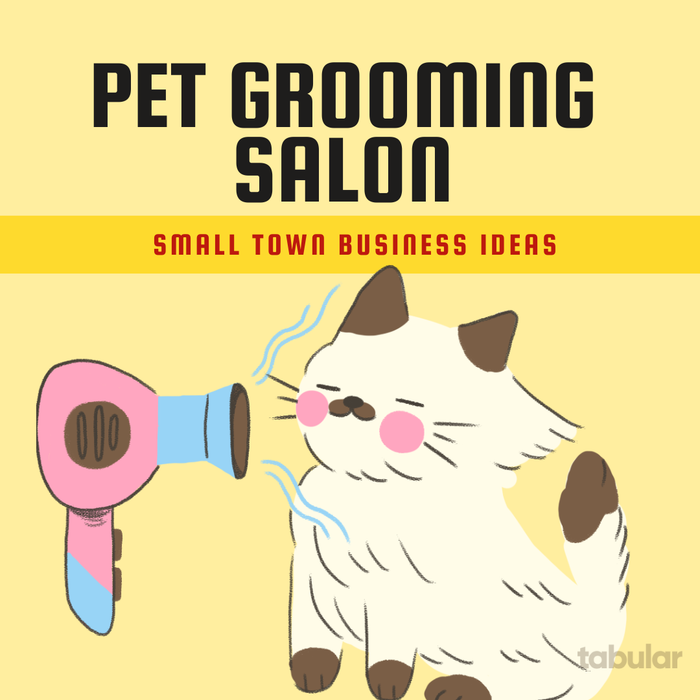
It provides a convenient local option for pet owners who would otherwise have to travel, and it is essential for the health and comfort of many dog breeds that require regular professional grooming to prevent painful skin conditions.
Requirements List:
- Professional groomer training and certification (essential for safety, technique, and insurability).
- A suitable commercial space with non-slip flooring, proper ventilation, and plumbing designed to trap pet hair.
- Professional grooming equipment: hydraulic grooming table, elevated bathing tub, high-velocity dryers, a set of professional clippers and blades, and various shears.
- A variety of professional-grade shampoos, conditioners, and grooming products.
- Secure holding kennels or crates for pets waiting for pickup.
- Comprehensive business liability insurance that specifically covers injury to animals in your care.
- A client management and scheduling software.
How to Start:
- Get Certified and Create a Business Plan: Complete a professional grooming program to master safe handling and techniques. Draft a detailed business plan that outlines your service menu, pricing structure, and target clientele.
- Secure Location and Legal Necessities: Find a location that meets zoning requirements for an animal care business. Register your business, get your permits, and, most importantly, secure your liability insurance policy.
- Purchase and Install Equipment: This is your largest capital expense. Invest in high-quality, professional-grade equipment that prioritizes both pet and groomer safety and ergonomics.
- Build a Client Base and Market: Begin marketing before you open. Create a social media page with a portfolio of your work (practice on friends' pets). Network with local veterinarians and pet supply stores for referrals. Offer an introductory discount to attract your first clients.
Things to Consider Before (Pitfalls):
- High Physical Demands: This is extremely physically demanding work that involves hours of standing, bending, and lifting animals. The risk of back problems, bites, and scratches is high.
- Significant Liability Risk: The health and safety of someone's beloved pet is in your hands. An accidental injury (a clipper burn, a cut, or stressing an elderly animal) can lead to devastating emotional and financial consequences.
- Difficult Clients (Both Human and Animal): You will have to manage anxious or aggressive dogs and, at times, pet owners with unrealistic expectations. Excellent animal handling and customer service skills are equally important.
- High Upfront Equipment Cost: Professional tubs, tables, and dryers are a significant investment and are not an area where you can cut corners.
- Burnout Potential: The combination of physical labor, the stress of ensuring animal safety, and managing customer demands can lead to high rates of burnout in the profession.
Costs:
- Initial Capital: $10,000 (for a very basic home-based setup) to $50,000+ (for a full build-out of a retail location with top-tier equipment).
- Estimated Profit: Very good potential. As a service-based business, once your initial equipment is paid for, margins on each groom are high. A successful, fully booked groomer can achieve net profit margins of 15-30%.
- Market Growth Rate: Strong. The pet industry is famously recession-resistant, and spending on pet services continues to grow steadily.
- Breakeven: 1 - 2 years. Profitability is directly tied to how quickly you can build a full and consistent schedule of clients.
12. The Professional Pet Sitter & Dog Walker
This is a professional service providing in-home care for pets when their owners are at work or on vacation. Services range from daily dog walking and drop-in visits (for feeding and potty breaks) to overnight and extended house-sitting.

The core purpose of this business is to provide peace of mind to pet owners by allowing their animals to stay in their own, familiar home environment, reducing stress compared to a traditional kennel. In a small town, it provides a crucial, trust-based service for residents who need reliable care for their pets.
Requirements List:
- Pet Sitter's Insurance and Bonding: This is non-negotiable. It protects you, the pet, and the owner's property.
- Animal First Aid & CPR Certification: Demonstrates professionalism and preparedness for emergencies.
- A reliable vehicle for traveling to clients' homes in all weather conditions.
- A smartphone with a good camera for sending updates to clients.
- A robust scheduling system (can be an app or a detailed calendar) to prevent double-bookings.
- A professional website or social media presence for marketing and client communication.
- A clear service contract and veterinary release form for clients to sign.
How to Start:
- Get Insured, Bonded, and Certified: This is the first and most important step to establish yourself as a professional, not just a hobbyist. It is your biggest selling point and legal protection.
- Establish Your Business Structure: Register your business name, set up a business bank account, and have a lawyer help you draft your service contract and liability waiver/vet release forms.
- Define Your Services and Pricing: Create a clear menu of services (e.g., 30-minute walk, 15-minute drop-in, overnight stay) and set your prices. Research what other sitters or kennels in the region charge.
- Market by Building Trust: In a small town, your reputation is everything. Network with local veterinarians, pet groomers, and pet supply stores—they are your best source of referrals. Create flyers for community boards and use local Facebook groups. Your initial goal is to get your first few clients who can then provide testimonials.
Things to Consider Before (Pitfalls):
- Immense Responsibility: You are responsible for the safety and well-being of a beloved family member and for the security of a person's home. The stress can be significant.
- Irregular and Demanding Schedule: You must work when others are away, which means nights, weekends, and major holidays are your busiest and most profitable times. The schedule is often unpredictable.
- High Risk of Burnout: Juggling multiple clients, managing different animal needs, and the often solitary nature of the job can lead to exhaustion.
- Emergencies are a Reality: You must be prepared to handle anything from a sick pet that needs an emergency vet visit to a home maintenance issue like a burst pipe.
- Inconsistent Income: Especially at the beginning, income can fluctuate wildly. A last-minute trip cancellation by a client can mean a significant loss of expected earnings for that month.
Costs:
- Initial Capital: $500 - $2,500. This is one of the lowest-cost businesses to start. Expenses are primarily for insurance, certification, business registration, and basic marketing materials.
- Estimated Profit: Very high margins. This is a service-based business where your primary cost is your time and transportation. Once you cover your low overhead, most of your revenue is profit.
- Market Growth Rate: Strong. As people increasingly view pets as family, the demand for premium, in-home care continues to grow.
- Breakeven: 2 - 6 months. Due to the extremely low startup costs, you can become profitable very quickly once you secure a few regular clients.
13. The Early Learning Daycare Center
A childcare daycare is a state-licensed facility that provides supervised care, socialization, and early childhood education for children, typically ranging from infants to pre-kindergarten age.
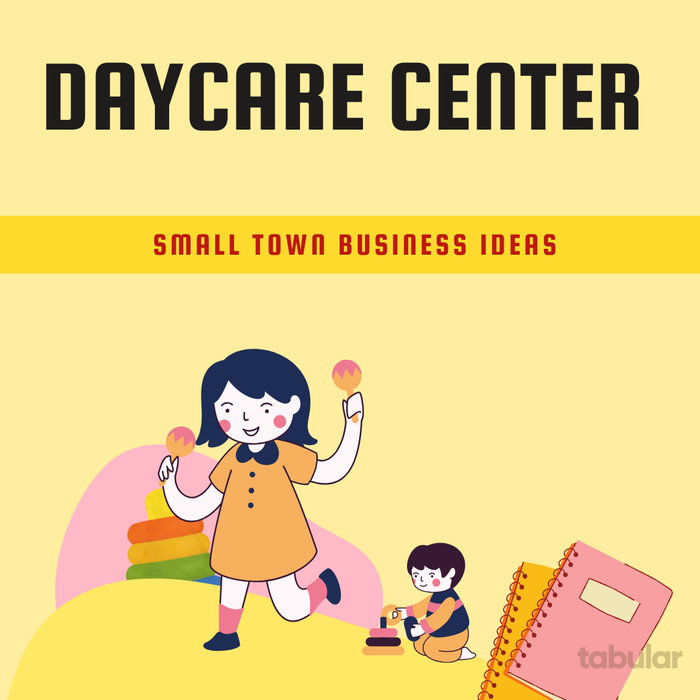
Its primary purpose is to offer a safe, structured, and nurturing environment for children while their parents or guardians are at work. In many small towns, the lack of quality childcare is a major barrier to employment for parents. This business is a cornerstone service that enables the local workforce, supports families, and provides foundational learning experiences for the community's youngest residents.
Requirements List:
- State Childcare License: This is the most critical and complex requirement, involving extensive background checks, facility inspections, and adherence to strict regulations.
- A Suitable Facility: The building must meet stringent safety codes (fire, health, sanitation), with specific square-footage requirements per child, a secure outdoor play area, and child-safe fixtures.
- Qualified Staff: A center director typically needs a degree in Early Childhood Education (ECE). All staff must pass background checks and have certifications in CPR, First Aid, and safe sleep practices.
- Strict Adherence to Ratios: You must maintain legally mandated staff-to-child ratios at all times, which vary by age group (e.g., 1 staff per 4 infants).
- Comprehensive Liability Insurance: Essential for protecting the business from the significant risks involved in caring for children.
- An Educational Curriculum: A structured, age-appropriate program for learning and development.
- Health and Safety Policies: Written plans for emergencies, illness, medication administration, and nutrition.
How to Start:
- Master Your State's Regulations: Before anything else, contact your state's childcare licensing agency. Study the handbook of rules and regulations. This will dictate your facility, staffing, and operational requirements. This step can take months.
- Create a Detailed Business Plan: Develop a comprehensive plan that includes your facility costs, staffing plan (including wages), curriculum, pricing, and a detailed budget. This is essential for securing a significant business loan.
- Secure a Location and Begin Licensing: Find a property that can meet or be renovated to meet all licensing codes. Submit your application for your license as early as possible, as the approval process is lengthy.
- Hire and Train Key Staff: Recruit a qualified Center Director and lead teachers. Conduct all necessary background checks and ensure their training and certifications are up to date.
- Equip the Center and Market: Purchase all necessary equipment: cribs, cots, changing tables, age-appropriate toys, and learning materials. Begin marketing your services and start a waitlist, which in a small town with high demand, can fill up quickly.
Things to Consider Before (Pitfalls):
- Extreme Government Regulation: Childcare is one of the most heavily regulated industries. Staying in constant compliance with an ever-changing rulebook is a massive and detail-oriented undertaking.
- Massive Liability and High Insurance Costs: The responsibility for the health and safety of young children is immense. Liability insurance is expensive for a reason, and a single serious accident can be catastrophic.
- Severe Staffing Challenges: Finding, affording, and retaining qualified early childhood educators is a nationwide crisis. The work is demanding and pay is often low, leading to very high staff turnover, which is disruptive for children and the business.
- High Overhead and Thin Profit Margins: High labor costs (due to ratio requirements), insurance, and facility expenses mean that profit margins are notoriously thin, often under 5%. This is a passion-driven business, not a highly lucrative one.
- Emotional and Physical Toll: The work is emotionally draining, dealing with the needs of many children, parent anxieties, and staff management. It is also physically demanding.
Costs:
- Initial Capital: $50,000 - $250,000+. This wide range depends on whether you are leasing and renovating a space or building a new facility. Costs include facility upgrades, licensing fees, insurance deposits, and a large amount of equipment.
- Estimated Profit: Typically very low, with net profit margins ranging from 2-8%. Success depends on maintaining full enrollment and tightly controlling costs.
- Market Growth Rate: Stable and high demand. In most small towns ("childcare deserts"), demand for quality care far exceeds the available supply.
- Breakeven: 3 - 5 years. The high initial investment and low margins mean it takes a significant amount of time to become profitable.
14. The Non-Medical Home Care Service
This is a non-medical service business that provides companionship and practical assistance to seniors who wish to remain in their own homes ("age in place").
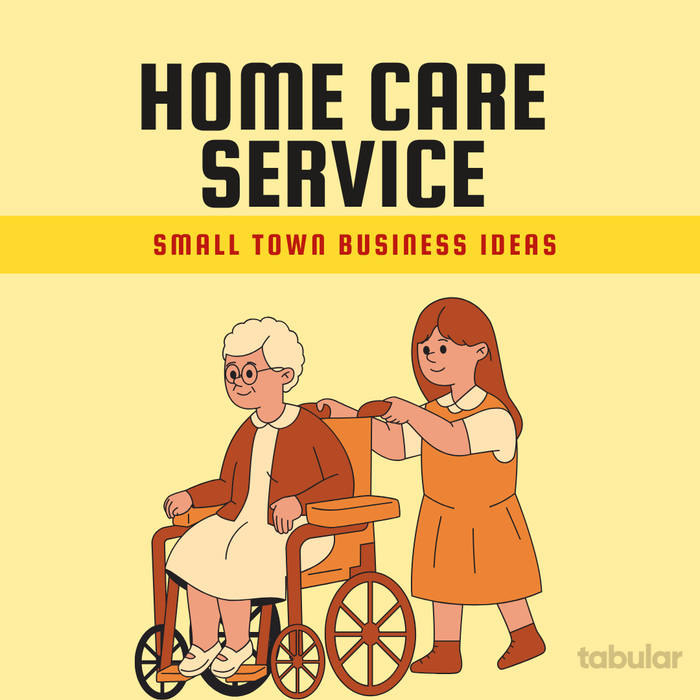
Its purpose is to support the daily living activities that become difficult with age, such as meal preparation, light housekeeping, errands, transportation to appointments, and medication reminders. It directly addresses the needs of a growing elderly population in small towns, providing a vital service that allows seniors to maintain their independence, safety, and social connections, while offering peace of mind to their families.
Requirements List:
- Comprehensive Liability Insurance and Bonding: This is the most important requirement to protect your clients, their property, and your business.
- Background Checks: Thorough criminal background checks for yourself and any employee are absolutely essential for building trust.
- Certifications: At a minimum, certifications in First Aid and CPR. Specialized training in dementia or Alzheimer's care is highly recommended and a major selling point.
- A Reliable and Insured Vehicle: Essential for transporting clients and running errands.
- A Formal Service Contract: A legally reviewed contract that clearly outlines services, hours, rates, and emergency procedures.
- A Business License and registration as a sole proprietorship or LLC.
- A system for scheduling clients and documenting care notes.
How to Start:
- Secure Insurance, Licenses, and Certifications: This is your foundation. Obtain your business license, purchase a robust liability insurance policy, and complete your First Aid/CPR certifications before seeking clients.
- Establish Your Business Structure: Register your business name and set up a separate business bank account. Consult with a lawyer to draft your client service agreement and liability waivers.
- Define Your Service Packages and Pricing: Create a clear menu of your non-medical services and set an hourly rate or package prices. Research what other agencies in the broader region charge to ensure you are competitive.
- Market by Building Community Trust: Your best marketing is networking. Introduce yourself and leave brochures at local senior centers, churches, doctors' offices, and pharmacies. Word-of-mouth referrals from trusted community figures will be your primary source of clients.
Things to Consider Before (Pitfalls):
- Significant Emotional Toll: You will be working closely with individuals who are lonely, ill, and facing end-of-life challenges. The emotional weight and stress can be immense.
- Huge Personal Responsibility: The safety and well-being of a vulnerable person are in your hands. The risk of a client having a fall or medical emergency while under your care is very real and a huge liability.
- Difficult Family Dynamics: You may find yourself caught in the middle of disagreements between the senior and their adult children about the level of care needed.
- Irregular and On-Call Hours: A client's needs don't adhere to a 9-5 schedule. You must be prepared for evening, weekend, and potential emergency calls.
- Scaling is Difficult: If you want to grow, finding and retaining trustworthy, compassionate, and reliable caregivers is exceptionally challenging and will become your biggest hurdle.
Costs:
- Initial Capital: $2,000 - $7,000. This is a low-cost startup. The main expenses are insurance, bonding, legal fees for your contract, and business registration.
- Estimated Profit: High profit margins. As a service business, especially if you are the sole provider, your primary costs are insurance and transportation. A large percentage of your hourly rate is profit.
- Market Growth Rate: Very Strong. The "aging in place" movement and the overall aging of the population (the "Silver Tsunami") make this one of the fastest-growing service industries.
- Breakeven: 3 - 9 months. With low startup costs, you can become profitable as soon as you secure one or two consistent, long-term clients.
15. The Local Lawn & Garden Service
This is a service-based business providing regular property maintenance for residential and small commercial clients. Its core functions include lawn mowing, hedge trimming, weeding, planting, and seasonal cleanups (like leaf removal in fall and garden prep in spring).

The business fills a crucial need for homeowners who lack the time, physical ability, or equipment to maintain their own properties. It enhances the overall curb appeal of the community and helps residents protect the value of their homes.
Requirements List:
- Reliable, Professional-Grade Equipment: A commercial-grade lawn mower (zero-turn is ideal), string trimmer, leaf blower, and hedge trimmer are the basics.
- A Work Vehicle: A reliable truck is necessary for transporting equipment. A trailer is highly recommended for hauling debris and larger mowers.
- General Liability Insurance: This is absolutely essential to protect you and your business in case of property damage or injury.
- A Business License and any other local permits.
- Safety Gear: Includes eye protection, hearing protection, sturdy boots, and gloves.
- A system for scheduling jobs and sending invoices.
How to Start:
- Acquire Core Equipment and Plan Services: Start with a focused list of services you can perform well (e.g., just mowing and trimming). Invest in the best quality equipment you can afford—reliability is key.
- Get Legal and Insured: Register your business as a sole proprietorship or LLC. Open a business bank account. Most importantly, purchase a comprehensive liability insurance policy before you step foot on your first client's property.
- Price Your Services and Find Your First Clients: Calculate your pricing based on the job, not just the hour, to account for travel, fuel, and equipment wear. Your first clients will come from your personal network (friends, family, neighbors). Print simple flyers and post them at local community hubs like the hardware store and post office.
- Deliver Excellent Work and Build Density: The quality of your work is your best advertisement. A beautifully manicured lawn is a billboard for your services. As you get clients, try to group them in the same neighborhoods to reduce travel time and maximize efficiency. Ask satisfied customers for referrals.
Things to Consider Before (Pitfalls):
- Underpricing Your Services: This is the most common failure point. New operators often fail to factor in all costs (fuel, insurance, equipment maintenance, travel time) and charge too little to be sustainable.
- Weather Dependency: A rainy week means no income. A drought can reduce the need for mowing. You must manage your cash flow to survive these unavoidable interruptions.
- Intense Physical Demand: This is hard, repetitive physical labor, often in hot or unpleasant weather. The risk of injury and burnout is high.
- Equipment is Your Lifeline: If your mower breaks down, your business stops. You must become proficient at basic maintenance and have a plan (and budget) for repairs and eventual replacement.
- Seasonality: In most climates, lawn care is a seasonal business. You must earn enough in the peak season to last through the winter, or develop off-season services like snow removal, holiday light installation, or handyman work.
Costs:
- Initial Capital: $3,000 - $15,000. The low end assumes you have a truck and buy good used equipment. The high end is for new commercial-grade equipment and a trailer.
- Estimated Profit: Once equipment is paid for, profit margins are high for a solo operator, as your main ongoing costs are fuel, insurance, and maintenance. Well-run lawn care businesses can see net profits of 15-30% of revenue.
- Market Growth Rate: Stable. The grass will always grow. The market is tied to the local housing market and economy.
- Breakeven: 3 months - 1 year. With low startup costs, profitability can be achieved quickly once you secure a roster of 10-15 regular, recurring clients.
16. The Commercial Property Maintenance Service
A building maintenance business provides contracted, ongoing upkeep and repair services for commercial and multi-unit residential properties. Its purpose is to act as the outsourced, all-in-one maintenance solution for small business owners, landlords, and property managers who do not have a full-time, on-staff maintenance person.
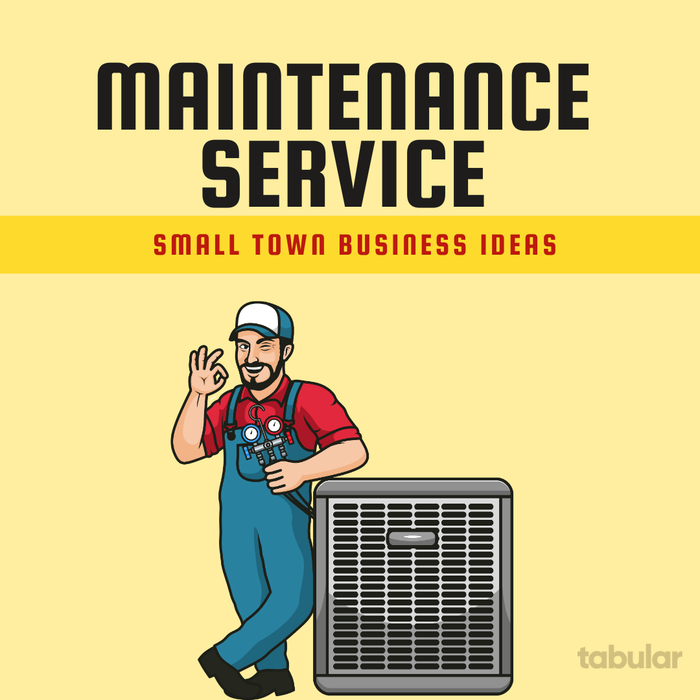
The service handles routine tasks (janitorial, preventative checks, groundskeeping) and minor repairs (plumbing, electrical, carpentry), ensuring that commercial properties remain safe, functional, and professional-looking.
Requirements List:
- Extensive General Liability Insurance: Higher coverage is needed for commercial work compared to residential.
- A Broad Skill Set: Proficiency in basic plumbing, electrical work (e.g., changing ballasts and outlets), carpentry, painting, and janitorial tasks.
- A Professional Work Vehicle: A van is often preferred over a truck to keep a wide array of tools and supplies secure, organized, and out of the weather.
- A Comprehensive Set of Professional Tools: This includes janitorial equipment (floor buffers, professional vacuums) in addition to standard trade tools.
- A Network of Licensed Tradespeople: You must have established relationships with licensed plumbers, electricians, and HVAC technicians for jobs that are beyond your legal scope.
- Legally Reviewed Service Contracts: A formal contract is essential for defining the scope of work, service frequency, and payment terms for each client.
How to Start:
- Assess Skills and Formulate a Plan: Honestly evaluate your range of abilities. Create a business plan that focuses on targeting specific types of commercial clients in your town (e.g., retail storefronts, medical offices, small apartment buildings).
- Get Licensed, Insured, and Legally Structured: Form an LLC for liability protection. Secure your business license and a robust general liability insurance policy. Have a lawyer draft a standard service contract you can adapt for each client.
- Acquire Professional Equipment: Invest in the vehicle and tools necessary to handle a wide variety of maintenance tasks efficiently and professionally.
- Market Directly to Businesses: This is a B2B sale. Go door-to-door and introduce yourself to the business owners and property managers on your target list. Network with commercial real estate agents. Offer a free "property health inspection" to demonstrate your value and identify needs. The goal is to sign clients to a monthly retainer/contract.
Things to Consider Before (Pitfalls):
- Knowing Your Legal Limits: The biggest risk is performing work that legally requires a licensed professional (e.g., major electrical or plumbing work). Doing so can result in huge fines, liability for damages, and voiding your insurance. You must know when to call in a specialist.
- The "On-Call" Expectation: Contracted clients may treat you as their 24/7 on-call service. Your contract must clearly define standard service hours versus emergency call-out fees and response times to manage expectations.
- Scope Creep: A client asking you to handle "just one more thing" outside of the contract is common. You must be firm but professional about what is included in the contract versus what requires a separate work order and charge.
- Managing Multiple Properties: Juggling the scheduled needs and unexpected problems of several different properties at once requires excellent organization and time management skills.
- Slow Payment from Clients: Commercial clients can sometimes be slow to pay invoices, which can create cash flow problems. You need sufficient operating capital to cover your own expenses while waiting for payments.
Costs:
- Initial Capital: $10,000 - $40,000. This is higher than a residential handyman due to the need for a professional van and a wider array of specialized tools and insurance.
- Estimated Profit: Stable and predictable once a client roster is built. Profit margins can be strong (20-35%) because you are selling reliability and peace of mind, not just labor.
- Market Growth Rate: Stable. Directly tied to the health of the local small business and rental property market.
- Breakeven: 1 - 2 years. It takes longer than residential work to build a base of contract clients, but once established, the income is much more consistent.
17. The Local Delivery & Courier Service
A local delivery service is a hyper-local courier business that transports goods from local businesses to residents, or runs personal errands. Its purpose is to bridge the convenience gap left by national delivery apps (like DoorDash or Uber Eats) that often do not serve smaller, less dense communities.

It provides a vital link for seniors, busy families, and anyone unable to leave their home, while also acting as an outsourced delivery fleet for local businesses like restaurants, pharmacies, and grocery stores that lack their own delivery infrastructure.
Requirements List:
- A reliable and fuel-efficient vehicle.
- Commercial Auto Insurance: This is different from personal insurance and is an absolute requirement for using your vehicle for business purposes.
- General Liability Insurance: Protects you if you damage a customer's property (e.g., drop their items).
- A smartphone with a data plan for navigation, communication, and processing payments.
- Insulated bags for safely transporting hot food and cold groceries.
- A simple payment processing system (e.g., Square, PayPal Zettle).
- A clear pricing structure (e.g., flat fee within town limits, per-mile charge outside).
- A business license.
How to Start:
- Get Legal and Insured: This is the most important first step. Form your business (LLC is recommended for liability protection), get your business license, and secure your commercial auto and general liability insurance policies.
- Define Your Services and Pricing: Decide exactly what you will deliver (restaurant food, groceries, prescriptions, hardware store items) and define your service area. Create a simple, easy-to-understand price list.
- Forge Business Partnerships: Go directly to local business owners—the pizzeria, the pharmacy, the local diner. Offer to become their official delivery partner. This creates a steady, reliable stream of orders and is more efficient than waiting for individual resident calls.
- Market Your Service: Once you have business partners, you have something concrete to market. Create flyers and business cards to leave at your partner locations. Use local Facebook groups to announce that residents can now get their favorite local food/goods delivered. Word-of-mouth will be crucial.
Things to Consider Before (Pitfalls):
- Underestimating Insurance Costs: Commercial auto insurance is significantly more expensive than personal insurance. Many fail to budget for this and operate illegally without it, creating a massive financial risk.
- High Vehicle Costs: Your profit is directly eaten by fuel, maintenance, and the rapid depreciation of your vehicle. You must factor these "hidden" costs into your pricing or you will lose money.
- Inefficient Downtime: There will be significant unpaid time between the lunch rush, afternoon errands, and the dinner rush. Profitability depends on scheduling multiple pickups/drop-offs efficiently and minimizing this downtime.
- Low Profit Per Trip: A $5 or $7 delivery fee doesn't leave much profit after vehicle expenses. You must achieve a high volume of deliveries per hour to make a decent income.
- Reliability is Everything: In a small town, your reputation is built on being dependable. One missed delivery or late arrival can damage your reputation significantly. You must be prepared to work in bad weather when demand is highest.
Costs:
- Initial Capital: $1,000 - $5,000. This is a very low-cost business to start. The primary expenses are insurance premiums, business registration fees, and marketing materials.
- Estimated Profit: Margins are tight and depend on volume. After factoring in vehicle expenses, net profit on each delivery may only be 40-60% of the delivery fee charged. Success is about completing many deliveries per day.
- Market Growth Rate: Strong. The demand for delivery and at-home convenience is a permanent market shift and is still an underserved market in most small towns.
- Breakeven: 2 - 6 months. Due to the very low startup costs, it's possible to become profitable very quickly once you secure a few key business partnerships that provide consistent order flow.
18. The Local Car Wash & Detail Center
A car wash is a facility dedicated to cleaning the exterior and interior of vehicles. This business can range from self-serve bays and automatic (touchless or soft-cloth) tunnels to high-end, hands-on detailing services.

Its purpose in a small town is to provide a convenient, professional-grade solution for vehicle maintenance that is superior to washing a car in a driveway. It serves everyone from residents wanting a quick rinse to those seeking meticulous detailing, helping to protect vehicle value from road salt, sun, and dirt.
Requirements List:
- A suitable commercial lot with high visibility and easy road access.
- Zoning and Environmental Permits: This is critical and often complex, involving water usage rights, drainage plans, and chemical disposal regulations.
- Car Wash Equipment: This could be self-serve pressure washing systems, an automatic wash tunnel, or professional detailing tools (buffers, extractors, steamers).
- A Water Reclamation System: Often legally required and essential for managing the high cost of water.
- Durable Building Structure: Bays and equipment rooms built to withstand constant moisture and chemical exposure.
- Comprehensive Liability Insurance: To cover potential damage to customer vehicles.
- A reliable payment system (credit card readers, coin-ops).
- (For detailing) At least one trained and skilled detailer.
How to Start:
- Decide on Your Model and Create a Plan: Choose your model: self-serve bays, an automatic tunnel, a hand-wash/detailing shop, or a hybrid. Research your local environmental regulations extensively. Create a detailed business plan to secure the significant funding required.
- Secure Funding, Land, and Permits: This is a capital-intensive business. Obtain a large commercial or SBA loan. Purchase or lease a suitable plot of land and immediately begin the long process of applying for all necessary zoning, building, and environmental permits.
- Construction and Installation: Work with contractors to build the facility according to code. Have your chosen equipment professionally installed by the manufacturer or a certified technician.
- Hire Staff and Market Your Opening: If you're offering detailing, hire and train your staff. Launch a marketing campaign leading up to your grand opening. Emphasize what makes you different—new equipment, better soaps, special detailing packages, or monthly wash club memberships.
Things to Consider Before (Pitfalls):
- Extremely High Initial Capital: The cost of land, construction, and specialized car wash equipment makes this one of the most expensive small businesses to start.
- Complex Environmental Regulations: You will be scrutinized by local and state agencies for your water usage and wastewater discharge. Fines for non-compliance are severe.
- Constant Equipment Maintenance: Car wash equipment operates in a harsh environment and breaks down frequently. You need to be mechanically inclined or have a significant budget for a reliable repair technician. A broken wash means zero income.
- High Utility Bills: Your water, sewer, and electricity bills will be substantial and directly impact your profitability.
- Weather and Seasonality: Your income is almost entirely dependent on the weather. A rainy week or a harsh winter can bring business to a complete halt, creating highly variable cash flow.
Costs:
- Initial Capital: $100,000 (for a basic two-bay self-serve) to $500,000+ (for a facility with a modern automatic tunnel and detailing bay).
- Estimated Profit: Margins can be good once the initial investment is paid down, due to low labor costs in automated models. Utility costs are the biggest variable. A well-managed wash can see net profits of 15-30%.
- Market Growth Rate: Stable. Tied to the number of cars in the community. Little organic growth, but you can capture more market share with a superior facility.
- Breakeven: 3 - 7 years. Due to the massive upfront investment, this is a long-term play that requires significant capital and patience to become profitable.
19. The Mobile Mechanic & Roadside Repair Service
A mobile mechanic is a professional automotive repair service that operates without a fixed garage. The mechanic travels directly to the customer's location—their home, workplace, or even the side of the road—to perform diagnostics, maintenance, and a wide range of repairs.
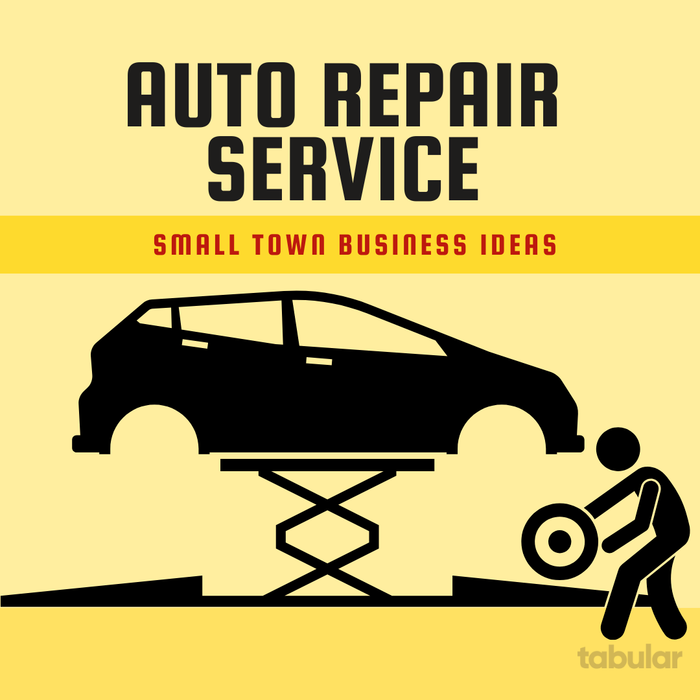
Its purpose is to provide an exceptionally convenient and often more affordable alternative to a traditional auto shop. In a small town with limited repair options, it solves the problem of getting a non-drivable car to a garage and eliminates the need for customers to arrange rides or wait in a shop.
Requirements List:
- ASE (Automotive Service Excellence) Certification: This is the industry standard and the single best way to prove your expertise and build instant trust.
- A reliable, well-organized work vehicle: Typically a large van or utility truck is required to carry all necessary tools and parts.
- A comprehensive set of professional-grade tools: This includes floor jacks, jack stands, a robust socket and wrench set, and advanced electronic diagnostic scanners (OBD-II).
- Specialized Business Insurance: This must include both General Liability and Garage Keeper's Insurance, which covers damage to a customer's vehicle while it is in your "care, custody, and control."
- A network of local auto parts suppliers for quick access to parts.
- A business license and any state-specific mechanic licensing.
- A system for mobile invoicing and payment processing.
How to Start:
- Get Certified and Insured: Your credibility and legal protection are paramount. Complete your ASE certifications and secure the correct, comprehensive insurance policies before you do anything else. Form an LLC to protect your personal assets.
- Acquire and Outfit Your Vehicle: Purchase a suitable work van or truck. Invest in the professional tools and diagnostic equipment needed to perform a wide range of jobs. Organize the vehicle for maximum efficiency.
- Define Your Service Menu and Pricing: Clearly define the services you can realistically perform on the road (e.g., brakes, alternators, starters, oil changes, tune-ups, diagnostics). Establish a clear pricing model, typically a service call fee plus an hourly labor rate, plus the cost of parts.
- Build Your Reputation and Market: Your professional van is your mobile billboard. Network with local auto parts stores—they are a primary source of referrals. Create simple business cards and flyers. In a small town, positive word-of-mouth from your first few successful jobs will be your most powerful marketing tool.
Things to Consider Before (Pitfalls):
- Job Scope Limitations: You cannot do everything a full-service garage can. Major repairs requiring an engine hoist or vehicle lift (e.g., transmission swaps) are impossible. You must be skilled at diagnosing what you can and cannot handle on-site.
- Weather is a Major Factor: You are completely exposed to the elements. Working in the rain, snow, or extreme heat is not only uncomfortable but can be unsafe and will lead to cancelled jobs and lost income.
- Parts Logistics: You don't have a parts department next door. A job often involves diagnosing the issue, driving to the parts store, and returning. This unpaid travel time must be factored into your pricing and scheduling.
- Physical Strain: Working on the ground is more physically demanding than working in a garage with a lift. The wear and tear on your body is significant.
- High Liability: If a repair fails and causes an accident, the liability is immense. Your expertise and insurance are your only protections. There is no "shop owner" to fall back on.
Costs:
- Initial Capital: $15,000 - $50,000+. The biggest costs are the work vehicle and the comprehensive set of professional tools and diagnostic equipment.
- Estimated Profit: High profit margins. With no rent or overhead from a physical garage, a large percentage of your labor rate is profit after accounting for fuel, insurance, and vehicle maintenance. Net margins can be 25-40%.
- Market Growth Rate: Stable. Cars will always need repairs. The demand for convenient, at-home services is growing.
- Breakeven: 6 months - 2 years. Profitability can be achieved relatively quickly once you have the equipment and build a small base of clients, thanks to the low overhead.
20. The Professional Cleaning Service
A professional cleaning service provides scheduled janitorial and housekeeping services for both residential homes (B2C) and commercial offices (B2B). Its purpose is to maintain a clean, healthy, and professional environment for its clients, freeing up their time and effort.
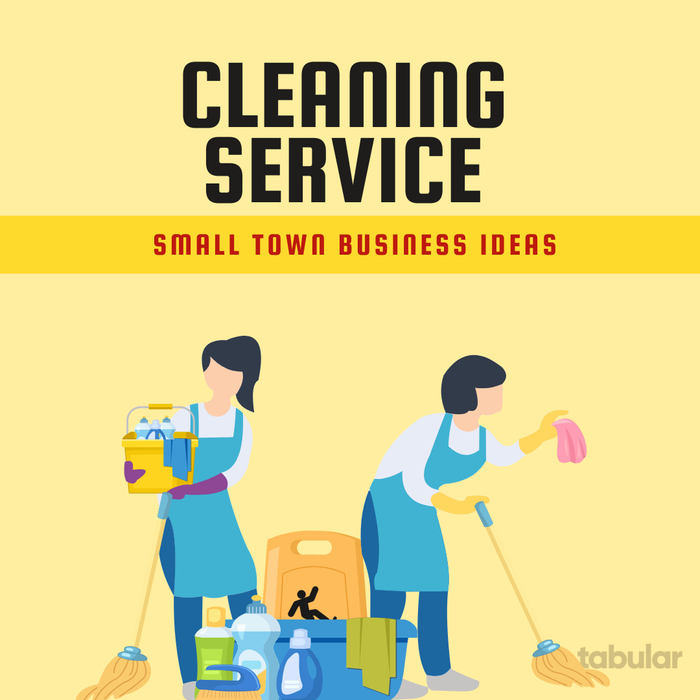
For homeowners, it offers convenience and helps maintain their property's value. For small businesses, it provides essential janitorial services that are crucial for employee health and client perception, but for which they cannot afford a full-time staff member.
Requirements List:
- General Liability Insurance and Bonding: This is non-negotiable. Insurance covers accidental damage, while bonding protects against theft, establishing you as a trustworthy professional.
- A reliable vehicle large enough to transport all necessary supplies.
- Professional-grade cleaning supplies and equipment: This includes a high-quality vacuum cleaner, a mop system, and a full kit of commercial-grade, safe cleaning solutions.
- A Business License and registration as an LLC (highly recommended for liability protection).
- A clear service checklist: This document details exactly what is included in a "standard clean" versus a "deep clean" to manage client expectations.
- A system for scheduling clients and invoicing.
How to Start:
- Get Insured, Bonded, and Legal: Before your first job, secure your liability insurance and bonding, register your business, and open a business bank account. This professionalizes your service and protects you.
- Acquire Supplies and Define Services: Purchase your initial set of professional supplies. Create detailed service checklists for different job types (e.g., residential, commercial, move-in/out). This prevents disputes about what was "included."
- Establish Your Pricing: Decide on a pricing model. You can charge by the hour or a flat rate per job. Flat rates are often preferred by clients but require you to accurately estimate your time. Calculate your rates to cover supplies, insurance, travel, and your time.
- Find Your First Clients: Your first clients will likely come from word-of-mouth. Network with local real estate agents (for move-out cleans), small business owners, and your personal contacts. A professional-looking flyer and a simple Facebook business page can be very effective in a small town.
Things to Consider Before (Pitfalls):
- Underpricing is a Common Failure: It's easy to forget to factor in the costs of supplies, insurance, taxes, and travel time. If you only charge for your active "cleaning time," your business will not be profitable.
- "Clean" is Subjective: Your idea of clean may differ from your client's. Using a detailed, signed-off checklist before you start work is the best way to ensure everyone is on the same page and to prevent callbacks.
- Physical Demands and Burnout: Cleaning is physically strenuous, repetitive work that can be hard on your back, knees, and hands. It's easy to get burned out if you overbook yourself.
- Trust is Everything: You are entering people's most private spaces. A single accusation of theft or breakage—even if false—can ruin your reputation in a small town. This is why being bonded is so important.
- Hiring is Hard: If you decide to grow, finding reliable, detail-oriented, and trustworthy employees is the single biggest challenge in the cleaning industry.
Costs:
- Initial Capital: $1,000 - $4,000. This is a very low-cost business to start. The primary expenses are insurance premiums, bonding, business registration, and the initial purchase of high-quality supplies and a vacuum.
- Estimated Profit: High profit margins. As a service business, your main ongoing costs are replaceable supplies and transportation. A large percentage of your revenue is profit, especially for a solo operator.
- Market Growth Rate: Stable. There is a consistent and steady demand for cleaning services in both residential and commercial sectors.
- Breakeven: 1 - 4 months. Due to the very low startup costs, you can become profitable as soon as you have secured a handful of regular, recurring clients.
21. The Local Photographer & Custom Print Studio
This business model combines professional photography services with a custom merchandise printing operation. As the photographer, you capture life’s key moments for the community—family portraits, senior photos, local sports teams, weddings, and business headshots. The "print studio" aspect adds a powerful second revenue stream: you take those images (or images provided by customers) and print them onto physical goods like T-shirts, coffee mugs, canvas prints, keychains, and holiday cards.

In a small town, this business becomes the go-to hub for all things visual and commemorative. Instead of residents turning to faceless online services for custom gifts or prints, they can come to a local person they know and trust. You can provide a personal touch, quicker turnaround times, and the ability to see and feel product samples. This model thrives by capturing community memories and then turning them into tangible keepsakes, creating a loyal, recurring customer base.
Requirements List:
- Professional-Grade Camera Gear: A reliable DSLR or mirrorless camera body, a versatile zoom lens (like a 24-70mm), and a prime portrait lens (like a 50mm or 85mm).
- Lighting Equipment: At least one external flash (speedlight), and ideally a simple studio lighting kit with softboxes or umbrellas for professional-looking portraits.
- Printing Equipment: This is key for the hybrid model. A high-quality sublimation printer, a heat press machine (for mugs, shirts, and flat items), and a professional photo printer for standard prints and canvases.
- Software Suite: Professional editing software like Adobe Lightroom and Photoshop is standard. You will also need basic design software (like Canva Pro or Adobe Express) for creating layouts for printed merchandise.
- A Portfolio and Online Presence: A clean, professional website showcasing your best photography work is essential. An active Facebook and/or Instagram page is critical for visibility in a small town.
- Physical Space (Optional but Recommended): A small studio or a dedicated room in your home to meet clients, conduct indoor photoshoots, and house your printing equipment. This adds a layer of professionalism.
- General Liability Insurance: Protects you if someone gets injured during a shoot or if you damage property.
- A Business License and registration as an LLC to protect your personal assets.
How to Start:
- Build Your Portfolio & Skills: Before you ask for a dime, you need proof of your skills. Offer free or heavily discounted sessions to friends and family to build a strong, diverse portfolio. Master your camera and editing software.
- Get Legal and Insured: Register your business name, open a separate business bank account, and secure your liability insurance. This is a non-negotiable first step to being a professional.
- Invest in Your Starter Gear: Purchase your essential camera, a versatile lens, and basic lighting. You can start the photography business first. For the printing side, begin with the most popular items: a good sublimation printer and a combination heat press for mugs and T-shirts are a great starting point.
- Establish Your Pricing: Create a clear price list. Have separate pricing for your photography sessions (e.g., session fee + digital image packages) and for your printed products. Research what online services charge, and price yourself competitively while highlighting the value of local service.
- Market Yourself Hyper-Locally: Create a Facebook Business Page and post your portfolio work regularly. Partner with other local businesses. Offer to take headshots for the local real estate agency or product photos for a new boutique in exchange for referrals. Offer to photograph a well-known local charity event or the high school football game to get your name and work seen by everyone.
- Launch Your Print Services: Once you have a few photography clients, market your new printing services directly to them. A family you just photographed is a perfect customer for custom holiday cards or a canvas print.
Things to Consider Before (Pitfalls):
- The High Cost of Entry: Unlike a cleaning service, photography and printing have a significant initial equipment cost. It's easy to spend thousands before you've made a dollar. Start with only the essential gear and upgrade as you grow.
- Competition from "Good Enough": Everyone has a smartphone with a great camera. Your value is not just in taking the picture, but in your expertise with lighting, composition, professional editing, and creating a comfortable experience. You must be able to clearly articulate why professional quality matters.
- The Feast-or-Famine Cycle: Photography work is often seasonal (e.g., busy during holidays, summer, and fall for weddings/seniors; dead in the winter). The custom printing side of your business is crucial for creating more consistent, year-round income (birthdays, gifts, etc.).
- Creative Burnout: The pressure to be creative on demand can be draining. You will also spend far more time on administrative tasks (editing, emailing, marketing, accounting) than you do behind the camera.
- Technical Failures are Disasters: A corrupted memory card can lose a client's wedding photos. A broken printer can delay a time-sensitive T-shirt order for a family reunion. Having backups for your files and a maintenance plan for your equipment is critical.
Costs:
- Initial Capital: $3,000 - $8,000. This is a medium-cost business. The range depends on the quality of camera gear and printing equipment you start with. Key costs are the camera/lenses, computer/software, heat press/printers, and initial stock of blank merchandise (mugs, shirts).
- Estimated Profit: Medium to High. Service-based photography has very high-profit margins. The printing side has lower margins due to material costs but can be scaled for high volume. The real profit comes from upselling print products to your photography clients.
- Market Growth Rate: Stable. There is a constant demand for capturing life milestones (births, graduations, weddings). The market for personalized gifts is also strong and growing.
- Breakeven: 6 - 18 months. Due to the higher startup costs, it takes longer to recoup your initial investment. Profitability depends heavily on how quickly you can build a consistent client base for both sides of the business.
22. The Wellness Studio & Gym
A wellness studio and gym is a local facility dedicated to physical fitness and health. This business model typically combines two key elements under one roof: a traditional gym area with cardio machines (treadmills, bikes) and strength equipment (free weights, resistance machines), alongside a separate studio space for scheduled group fitness classes like yoga, Pilates, HIIT, or senior-focused mobility classes

In a small town, this business fills a critical gap by providing a convenient, accessible, and community-focused place for residents to exercise. It eliminates the need for long drives to larger, more impersonal gyms in neighboring cities. Its purpose is to be the town's central hub for health, offering a variety of options that appeal to different ages and fitness levels—from high school athletes to working adults and retirees. The social, community aspect is as important as the equipment; it's a place where people meet, build relationships, and stay motivated together.
Requirements List:
- Commercial Space: A suitable ground-floor location (1,500 - 3,500 sq ft) with high ceilings, proper ventilation, and adequate parking. Must have space for restrooms and ideally, a small shower area.
- High-Liability Insurance: This is absolutely mandatory and will be one of your biggest operating costs. It must cover potential member injuries on-site.
- Fitness Equipment:
- Cardio: A foundational set of commercial-grade treadmills, elliptical trainers, and stationary bikes.
- Strength: A squat rack, barbell with plates, a full set of dumbbells (5-100 lbs), adjustable benches, and a few basic cable/resistance machines.
- Studio: Yoga mats, blocks, resistance bands, and light hand weights.
- Business License and LLC: An LLC is essential to protect your personal assets from business liabilities, which are significant in this industry.
- Membership Management Software: A system to handle automated recurring payments, member check-ins, and class scheduling is not optional. It is the core of your administrative operations.
- Certified Staff: You or your staff must have nationally recognized certifications (e.g., NASM or ACE for personal training, RYT for yoga) to ensure safety, credibility, and to be compliant with your insurance policy.
How to Start:
- Create a Solid Business Plan & Secure Funding: This is a high-cost business. Your first step is to create a detailed business plan outlining your target market, equipment costs, and financial projections. This plan is necessary to secure a small business loan.
- Find and Lease Your Location: The location is paramount. It needs to be easy to find and access. Negotiate your lease carefully before making any major purchases.
- Get Legal, Insured, and Set Up Finances: Form your LLC, open a business bank account, and secure your liability insurance. Do not allow a single piece of equipment to be used before your insurance is active. Get client liability waivers drafted by a lawyer.
- Purchase and Install Equipment: To save money, look for high-quality used commercial equipment from gyms that are closing or upgrading. Start with the essentials and add more specialized pieces as your membership grows.
- Hire Instructors and Set a Schedule: Find certified, reliable instructors for the classes you plan to offer. Develop a clear class schedule and pricing structure for different membership tiers (e.g., gym-only, unlimited classes, punch cards).
- Market Before You Open: Start a Facebook page and post progress pictures of the build-out. Offer a significant "Founder's Membership" discount for the first 50-100 people who sign up before opening day. This generates crucial initial cash flow and community buzz.
Things to Consider Before (Pitfalls):
- Extremely High Overhead Costs: Your monthly rent, loan payments, insurance premiums, and utilities create immense financial pressure. You need a significant number of members paying every month just to cover your fixed costs.
- Liability and Injury Risk: A member getting seriously injured is the single biggest risk to your business. Your entire operation must be built around safety, proper instruction, and solid insurance coverage. Waivers help but do not prevent lawsuits.
- Membership Churn is Inevitable: People's motivation comes and goes. The "January Rush" is real, but so is the "Summer Slump." Your business model must focus on member retention through community events, fitness challenges, and excellent customer service to combat this churn.
- Equipment is Expensive to Maintain and Replace: Commercial gym equipment takes a beating. You must budget for regular maintenance, repairs, and eventual replacement, which can cost thousands of dollars per machine.
- You Are Not Just a Gym Owner; You Are a Community Manager: A small-town gym thrives on its atmosphere. You will spend a huge amount of time talking to members, resolving minor conflicts, and fostering a positive, non-intimidating environment. This is a people-first business.
Costs:
- Initial Capital: $25,000 - $100,000+. This is a high-cost startup. The range depends entirely on the size of your space and whether you buy new or used equipment. The primary costs are equipment purchases, lease deposits, and initial insurance payments.
- Estimated Profit: Medium. While revenue from memberships is recurring, the high fixed overhead costs (rent, insurance, loans) mean profit margins are tighter than in a service-only business. Profitability is directly tied to achieving and maintaining a high volume of members.
- Market Growth Rate: Stable. The demand for health and fitness is consistent. In an underserved small town, the convenience factor creates a very durable local market.
- Breakeven: 18 - 36 months. Due to the very high initial investment and monthly overhead, it takes a long time to become profitable. This is a long-term commitment, not a get-rich-quick business.
23. The Small Town Event Planner
An event planner is a professional project manager for special occasions. They are hired to design, coordinate, and execute events, saving clients time, money, and stress. The planner handles everything from budgeting and vendor selection to on-the-day coordination.

In a small town, this business is not just for large, lavish weddings. It becomes the go-to service for a wide range of local gatherings: 50th-anniversary parties, family reunions, high school reunions, community fundraisers, and grand openings for other local businesses. The primary value in a small town is the planner's network. They know which local caterer is reliable, what church hall has the best kitchen, who rents tables and chairs, and which photographer is best for different types of events. They act as the single point of contact, managing all the moving parts so the client can enjoy their own event.
Requirements List:
- General Liability Insurance: Non-negotiable. This protects you if a vendor you hired causes damage or if a guest is injured due to your setup.
- A Professional Portfolio: A visual collection (website, high-quality binder, or social media page) of events you have planned. This is your proof of competence.
- A Curated Vendor List: A detailed, vetted list of local and regional vendors (caterers, florists, photographers, venues, DJs, rental companies). This is your most valuable asset.
- Rock-Solid Contracts: You need two main types: a Client Service Agreement that clearly outlines your services, fees, and what is not included, and a contract to use with your vendors. These must be drafted by a legal professional.
- Organizational System: A project management tool (like Trello, Asana, or even just a highly organized system of spreadsheets and checklists) to track budgets, timelines, and vendor communications for multiple clients.
- Business License and LLC: An LLC is strongly recommended to separate your business liability from your personal assets.
How to Start:
- Get Experience (Even if Unpaid): Offer to plan an event for free for a local non-profit, your church, or a friend's significant party (like a baby shower or anniversary). This is not for practice; it is to build your initial portfolio and get testimonials. Document everything with good photos.
- Build Your Vendor Network: This is an active job. Schedule meetings with local venue managers, caterers, and photographers. Introduce yourself and your business. Ask about their services and pricing. You need these relationships before a client asks for them.
- Get Legal and Insured: Form your LLC, open a business bank account, and get your liability insurance in place. Draft your client and vendor contracts. Do not take on a paying client until this is done.
- Define Your Services and Pricing: Decide on your pricing structure. Common models include a flat fee per event, an hourly consulting rate, or a percentage of the total event budget (typically 15-20%). Create clear service packages (e.g., "Full Planning," "Day-Of Coordination").
- Market Yourself Locally: Create a simple website and a professional Facebook page showcasing your portfolio. Join the local Chamber of Commerce. Network with venue owners and caterers—they are your biggest source of referrals. Your first clients will come from word-of-mouth.
Things to Consider Before (Pitfalls):
- Your Reputation is Tied to Your Vendors: If the caterer is late or the DJ is unprofessional, the client will blame you. Your reputation is only as good as the weakest vendor you recommend. A limited vendor pool in a small town makes this even more challenging.
- Scope Creep Will Kill Your Profit: Clients will constantly ask for "one more little thing." A solid contract that clearly defines the scope of your work is your only defense. You must be comfortable saying, "That's a great idea! It's outside our original agreement, but I can add that service for an additional fee."
- Managing Emotions is Part of the Job: You are dealing with people during highly stressful and emotional times (weddings, funerals, etc.). You must remain calm, organized, and professional when everyone around you is not. You are a problem-solver, not just a party-thrower.
- The "Friend Price" Expectation: In a small town, you will know many of your potential clients personally. They will often expect a discount. You must establish yourself as a professional business with set prices from the very beginning.
- Burnout from Irregular, Intense Hours: The work is 90% administrative (emails, phone calls, spreadsheets) and 10% on-site chaos. Event days are often 14+ hours on your feet. The work is not glamorous; it is logistics and crisis management.
Costs:
- Initial Capital: $500 - $2,500. This is a very low-cost business to start. There is no equipment to buy. Your main costs are LLC registration, insurance premiums, legal fees for contract drafting, and a professional website.
- Estimated Profit: Very High. As a pure service business, your overhead is extremely low. The vast majority of your revenue is profit after covering basic business expenses like insurance and marketing.
- Market Growth Rate: Stable. There will always be a need for events like weddings, milestone anniversaries, and community gatherings. Demand is consistent.
- Breakeven: 1 - 3 months. Because startup costs are so low, you can be profitable after booking your very first significant event.
24. The Catering Service
A catering service prepares, delivers, and often serves food for private and public events. Unlike a restaurant, a caterer does not have a daily public storefront or dining room. Instead, they operate out of a licensed commercial kitchen and transport food to a client's specific location, such as a community hall, a business office, a wedding venue, or a private home.
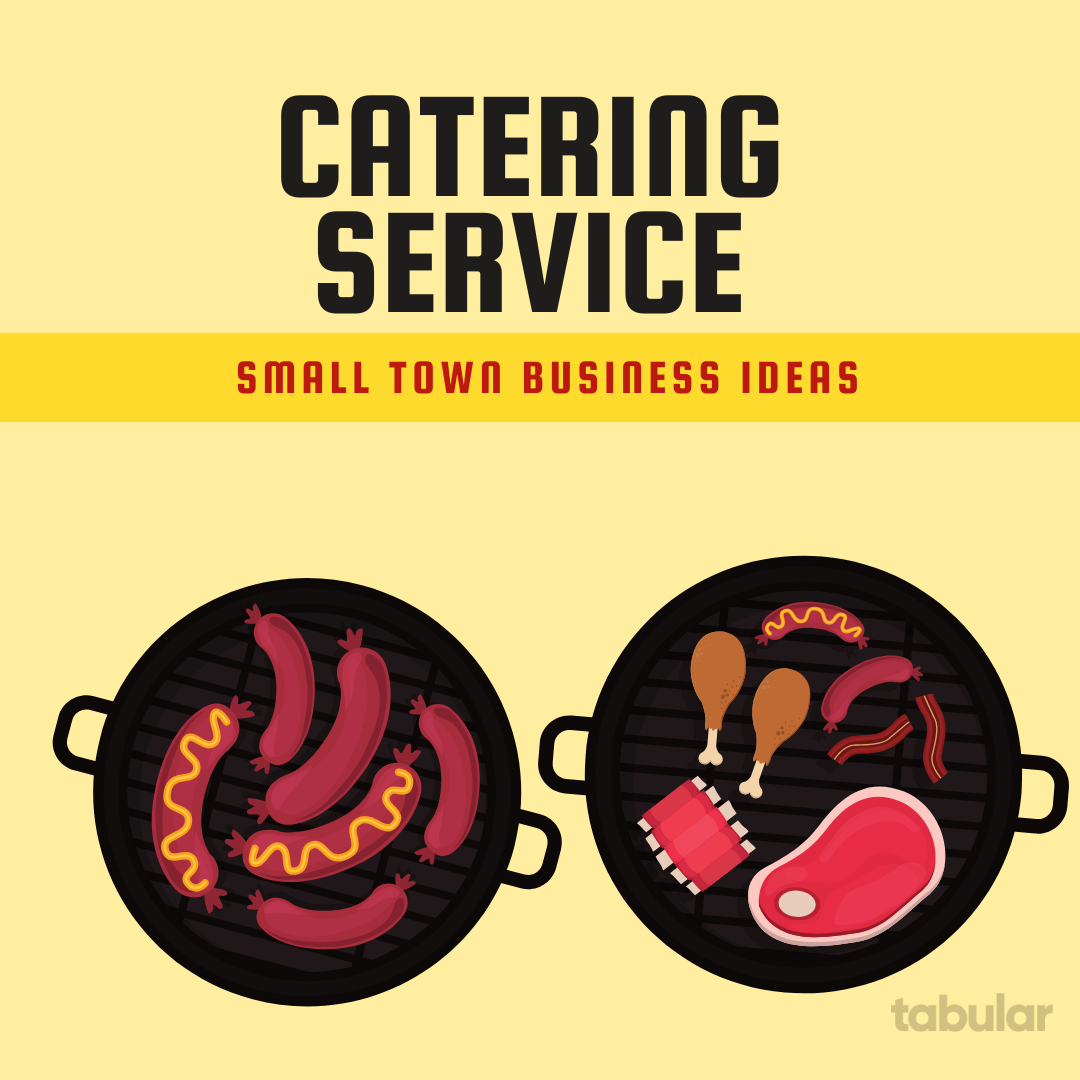.png?w=700&fit=max&auto=format)
In a small town, a reliable caterer is an essential service. They become the go-to food provider for nearly every significant local event: business luncheons, school board meetings, funeral receptions, holiday parties, weddings, and family reunions. The caterer's value is providing high-quality food for groups larger than a person could cook for at home, removing a massive logistical burden from the event host. They offer a level of professionalism and safety that potlucks cannot, becoming a trusted and indispensable part of the community's social fabric.
Requirements List:
- A Licensed Commercial Kitchen: This is the most critical and non-negotiable requirement. You cannot legally operate a catering business out of your home kitchen. You must either build out your own licensed kitchen or rent space in a certified commissary kitchen.
- Health Department Permits and Food Handler's Licenses: You will need a food enterprise permit from your local health department for your kitchen, and you and any staff must have food handler's certifications.
- Product and General Liability Insurance: General liability covers accidents on-site. Product liability is even more important, as it covers you if someone gets sick from your food. This is mandatory.
- Reliable Transportation: A clean, reliable vehicle, preferably a van, that can safely transport food.
- Food Holding and Serving Equipment: Professional-grade insulated carriers ("hot boxes") to keep hot food hot and cold food cold during transport. You will also need chafing dishes, serving platters, and utensils.
- Contracts: A clear, legally reviewed service contract that details the menu, service level, total cost, payment schedule, and cancellation policy.
- Reliable Food Suppliers: Established relationships with local grocers, butchers, or a regional food service distributor (like Sysco or US Foods).
How to Start:
- Solve the Kitchen Problem First: Before you do anything else, secure your legal cooking space. Research local commissary kitchens you can rent by the hour or find a commercial space to build out. This step determines your entire startup cost and feasibility.
- Get Certified, Licensed, and Insured: Complete your food handler's certification. Apply for all necessary health department and business permits. Form your LLC and purchase your liability insurance. Do not cook for a single paying customer until these are in place.
- Develop a Smart, Focused Menu: Do not try to offer everything. Start with 3-4 complete menu packages you can execute flawlessly (e.g., a "Business Lunch" package, a "Classic Buffet" package). Perfect these offerings first.
- Calculate Your Pricing Meticulously: A common industry rule is to price a menu item at 3-4 times your food cost to cover labor, overhead (insurance, kitchen rental), and profit. Create a detailed spreadsheet for every menu item.
- Acquire Your Essential Equipment: Buy your initial set of hot boxes, chafing dishes, and serving utensils. You can rent specialty items or extra dishes as needed for larger jobs to keep initial costs down.
- Market by Building Relationships: Your primary customers will be other businesses and organizations. Introduce yourself to local event planners, funeral home directors, and office managers at large local businesses. Offer a free tasting or a discounted lunch. Their referrals are your best marketing tool.
Things to Consider Before (Pitfalls):
- Food Safety is Everything: A single incident of foodborne illness can permanently ruin your reputation and end your business. You must be obsessive about food safety standards, especially temperature control during transport and service.
- Underpricing Will Bankrupt You: Forgetting to factor in the cost of your labor, shopping time, gas, insurance, and cleanup is a classic failure. If you only charge for the ingredients, you are operating a non-profit.
- Logistics are More Complex than Cooking: The hardest part of catering is not the food; it's the logistics of getting that food for 100 people to a remote location, on time, at the right temperature, and served professionally. This requires military-grade planning.
- It is Incredibly Physically Demanding: Catering involves long hours on your feet, heavy lifting (pots, cases of drinks, equipment), and working under high pressure on nights and weekends.
- Waste and Inventory Management: Misjudging the amount of food needed can be costly. Too little, and the client is angry; too much, and your profit is eaten by waste. Experience is the only way to get this right.
Costs:
- Initial Capital: $5,000 - $150,000+. This range is enormous and depends almost entirely on your kitchen situation. Low End ( 5k−15k): If you rent space in an existing commissary kitchen and start with basic equipment. High End ( 50k−150k+): If you lease a space and have to build out a commercial kitchen from scratch.
- Estimated Profit: Medium. Food and labor are significant, variable costs that eat into revenue. Profit margins typically range from 10-15% of total revenue, depending on your efficiency and pricing strategy.
- Market Growth Rate: Stable. In a small town, there is a constant, predictable need for event food services. A good caterer can dominate the local market.
- Breakeven: 6 months - 4 years. Highly dependent on your startup costs. If you start lean by renting a kitchen, you can be profitable within the first year. If you take on a large loan to build a kitchen, it will take several years to break even.
25. Digital Marketing Specialist
A digital marketing specialist is a consultant who helps other local businesses get found and attract customers online. Their job is to manage a business's online presence. This includes services like running their social media accounts (Facebook, Instagram), improving their ranking on Google Maps and search results (SEO), creating and sending email newsletters, and running local online ads.
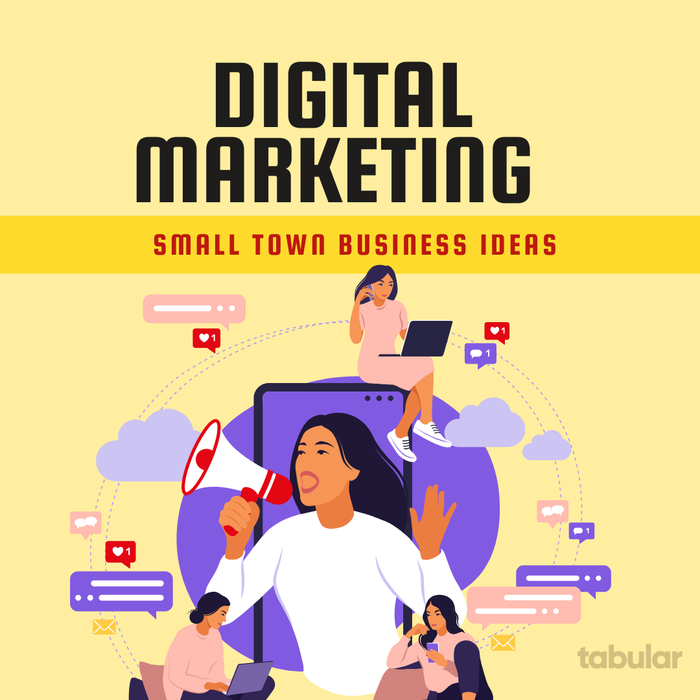
In a small town, this business is the digital expert for Main Street. Most small business owners (like plumbers, diner owners, or boutique retailers) are experts at their craft but lack the time, skills, or interest to manage their online marketing effectively. The specialist steps in as a local, trusted partner to handle it for them. Their goal isn't to compete with giant marketing agencies; it's to provide practical, affordable services that produce tangible results, like more phone calls, more website clicks, and more foot traffic into a local store.
Requirements List:
- Demonstrable Skills: You must be proficient in the core areas of digital marketing:
- Social Media Management: Specifically Facebook and Instagram, which are key for local communities.
- Local SEO (Search Engine Optimization): Primarily managing and optimizing a "Google Business Profile" is the single most valuable skill for a local business.
- Paid Advertising: Knowledge of how to run effective, small-budget ads on Facebook Ads and Google Ads.
- Email Marketing: Ability to use platforms like Mailchimp or Constant Contact to build a customer email list and send promotions.
- A Professional Website and Portfolio: You need your own professional website to prove you can do the work. The portfolio should feature case studies (even if from pro-bono work) showing results (e.g., "Increased Facebook engagement by 150% for [Local Non-Profit]").
- Client Management and Reporting Tools: A system to manage multiple clients (like Trello or Asana) and a way to create simple, easy-to-understand monthly reports that show clients what they are paying for.
- Liability Insurance (Errors & Omissions): This protects you if you make a mistake that costs a client money (e.g., an ad with the wrong phone number).
- A Solid Client Contract: A legally reviewed contract that clearly outlines the scope of work, deliverables, fees, and termination clauses. This prevents "scope creep."
- Business License and LLC: An LLC is highly recommended to protect your personal assets.
How to Start:
- Get Proof of Concept: You need results to show. Offer to manage the digital marketing for a local non-profit or a friend's business for free or for a very low "case study" fee for 3-4 months. Document your process and track every metric. This becomes your initial portfolio.
- Build Your Own Platform: Before selling services to others, make sure your own digital house is in order. Create a professional website, optimize your own Google Business Profile, and run your own active social media pages. This is your live resume.
- Get Legal and Draft Your Contract: Form your LLC, open a business bank account, and get your insurance. Work with a legal professional to draft a standard client service agreement.
- Create Service Packages: Don't just sell your time. Create clear, easy-to-understand monthly packages. For example:
- "The Social Starter": $400/month for managing Facebook & Instagram.
- "The Local Visibility Booster": $500/month for Google Business Profile optimization and management.
- "The All-in-One Partner": A higher-priced retainer for all services.
- Network and Find Your First Paying Client: Your first clients will come from local connections. Join the Chamber of Commerce. Go to local business meetups. Offer a free "30-Minute Digital Audit" to business owners to show them where they are falling short online and how you can help.
Things to Consider Before (Pitfalls):
- Proving Your Value (ROI): Small business owners are practical. They don't care about "likes" or "impressions"; they care about the phone ringing. You must focus on tracking and reporting metrics that matter to them (phone calls from Google, website contact form submissions, foot traffic).
- The "My Nephew Can Do It for Free" Problem: Many business owners undervalue digital marketing because it seems easy. You must be able to clearly articulate the value of professional strategy versus just "posting stuff."
- Unrealistic Expectations: A client with a $300/month budget may expect to double their business overnight. You must manage expectations from the very first conversation and in your contract. Under-promise and over-deliver.
- The Industry is Always Changing: Google and Facebook are constantly updating their platforms and algorithms. You must dedicate time every week to continuing education (reading blogs, taking courses) just to stay current. This is a non-negotiable part of the job.
- Getting Paid: Chasing down payments from small businesses can be a challenge. Setting up automated recurring billing through a system like Stripe or QuickBooks is the best way to ensure you get paid on time, every time.
Costs:
- Initial Capital: $500 - $2,000. This is a very low-cost business to start. Your primary expenses are business registration (LLC), insurance, a professional website, and subscriptions to a few key software tools (like Canva Pro or a social media scheduler).
- Estimated Profit: Extremely High. This is a pure service business. Once you cover your low monthly software and insurance costs, the vast majority of your client revenue is profit. Your main cost is your time.
- Market Growth Rate: High. The number of small businesses that know they need to be online but don't know how is massive and growing. The demand for competent, trustworthy digital marketing help is very strong.
- Breakeven: 1 - 3 months. Due to the extremely low startup and overhead costs, you can be profitable as soon as you land your first or second monthly retainer client.
26. The Local Web Developer
A local web developer builds, launches, and maintains websites for other small businesses. This service does not require a formal computer science degree. Instead, it relies on mastering powerful and popular platforms like WordPress (for general business websites, blogs, and service-based businesses) and Shopify (for businesses that want to sell products online).

In a small town, you are the go-to "digital construction" expert. You help the local plumber, the downtown boutique, and the family restaurant establish a professional online presence. Your job is to create a site that looks modern, works on mobile phones, shows up on Google, and makes it easy for customers to find information or make a purchase. You provide a local, face-to-face service that is less intimidating and more accountable than a faceless online agency, and you can offer ongoing support for a monthly fee.
Requirements List:
- Mastery of a Platform: Deep proficiency in either WordPress (including a popular page-builder like Elementor) or Shopify. You must know the platform inside and out.
- Basic Technical Skills: A fundamental understanding of how domains and web hosting work. Basic knowledge of HTML and CSS is not strictly required but is a major advantage for making custom tweaks and troubleshooting issues.
- A Professional Portfolio Website: This is your #1 sales tool. Your own website must be perfectly designed and functional to prove your skills. It should showcase 2-3 examples of sites you have built (even if they were practice projects or for non-profits).
- A Reliable Computer and Internet: These are your primary tools of the trade.
- Design and Project Management Software: Access to a graphic design tool like Canva Pro or Figma for creating simple logos and web graphics, and a system like Trello to manage client projects.
- An Ironclad Client Contract: A legally reviewed contract that clearly defines the project scope (e.g., number of pages), deliverables, timeline, payment schedule, and what happens after the site is launched.
- Business License and LLC: An LLC is crucial to protect your personal assets from any business liabilities.
- Errors & Omissions (E&O) Insurance: This protects you if a technical error you make causes a client to lose business.
How to Start:
- Choose Your Platform and Skill Up: Pick either WordPress or Shopify and dedicate yourself to mastering it. Use online courses (Udemy, YouTube), build multiple practice projects, and learn how to solve common problems.
- Build Your Portfolio: Create your own professional website. Then, offer to build a website for a local non-profit or a friend's business for free or at a steep discount. This is not for charity; it is to get a real project, a testimonial, and a portfolio piece.
- Get Legal and Set Up Your Business: Form your LLC, open a business bank account, get your E&O insurance, and have a lawyer help you draft your standard client contract.
- Create Your Service Packages: Don't sell hours, sell solutions. Create clear, flat-fee packages. For example:
- "The Digital Brochure" Package ($1,500): A 5-page WordPress site with a contact form.
- "The Main Street E-Commerce" Package ($2,500): A fully configured Shopify store with up to 20 products loaded.
- Monthly Website Care Plan ($75/month): Includes software updates, security scans, and one hour of content changes. This is your key to recurring revenue.
- Find Your First Clients: Actively look for local businesses with outdated (or non-existent) websites. Send a direct, helpful email: "Hi [Business Owner], I'm a local web developer. I noticed your website isn't mobile-friendly. I'd be happy to show you how a modern site could help you attract more customers."
Things to Consider Before (Pitfalls):
- The Content Holdup: The single biggest reason projects stall is waiting for the client to provide text and images. Your contract must state that the project timeline is dependent on the client delivering content by a specified date.
- Scope Creep is Inevitable: Clients will always ask, "Can we just add one more thing?" Your contract is your only defense. You must be comfortable saying, "Absolutely, we can add that feature. That falls outside our original agreement, and the additional cost will be X."
- Post-Launch Abandonment vs. Perpetual Support: Clients often assume you will provide free support forever. You must be crystal clear from the beginning that once the site is launched, your work is done unless they sign up for a monthly "Care Plan." This plan is your most important product.
- You Are Responsible for Security: If you build and/or host a client's website and it gets hacked, they will blame you. You are responsible for using strong passwords, keeping software updated, and implementing basic security measures.
- Competition from DIY Builders (Wix, Squarespace): A business owner might ask, "Why shouldn't I just use Squarespace?" Your value is not just the website; it's the strategy, custom implementation, SEO setup, and ongoing local support. You are selling a complete, done-for-you solution, not just a tool.
Costs:
- Initial Capital: $500 - $2,500. This is a very low-cost business. The main expenses are for business registration, insurance, a premium theme/plugin license, website hosting, and maybe a professional contract template.
- Estimated Profit: Extremely High. This is a service-based business with very low overhead. A large percentage of project fees and nearly all recurring revenue from care plans is profit.
- Market Growth Rate: High. Every serious business needs a professional website, and websites need to be redesigned every 3-5 years to stay modern. The demand is constant.
- Breakeven: 1 - 3 months. With low startup costs, you can be profitable after your very first client project.
27. Bike Rental
A bike rental business provides bicycles for short-term use, typically charging by the hour or by the day. The service allows both tourists and locals to explore the area without needing their own bike.
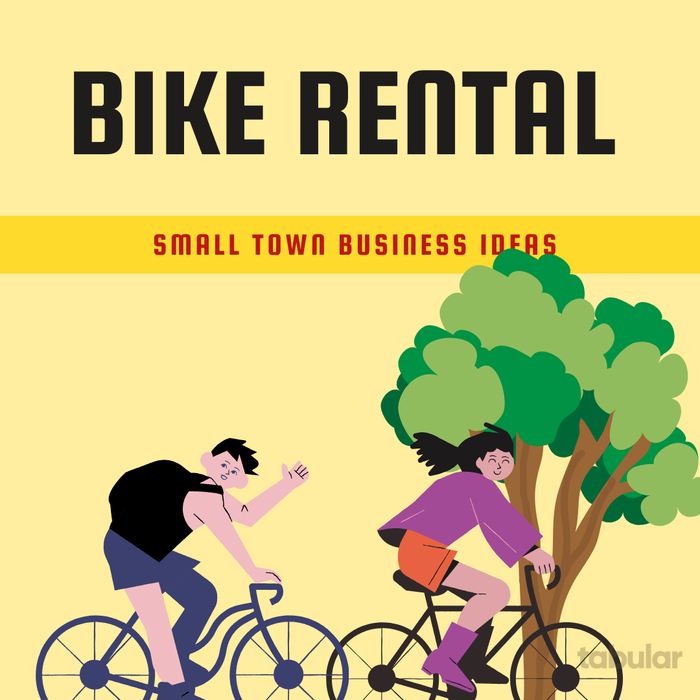
In a small town, this business leverages the town's unique character and scenery. It's not about commuting; it's about recreation. You provide bikes for leisurely rides through a historic downtown, along a scenic river path, or to a local park or swimming hole. This business becomes a key tourism asset, often partnering with local hotels, B&Bs, and the visitor center. For locals, it offers a fun activity for visiting family or a way to enjoy a bike ride without the cost and maintenance of ownership.
Requirements List:
- A Fleet of Bicycles: A starting fleet of 10-15 well-maintained, user-friendly bikes (like beach cruisers or simple multi-speed hybrids) is a good goal. You'll also need a few kids' bikes.
- Safety Equipment: A full inventory of helmets in various sizes is mandatory. Bike locks for every bicycle are also essential.
- Massive Liability Insurance: This is the most important requirement. The risk of a customer getting injured is significant, and standard business insurance is not enough. You need a specific policy that covers rental operations.
- Legally-Reviewed Liability Waiver: A lawyer must draft a rock-solid waiver that every single customer signs before riding. This is your first line of defense against lawsuits.
- A Physical Location: You need a visible and accessible spot to store bikes and serve customers. A small storefront in a high-foot-traffic area (near the town square, a park, or a main trail head) is ideal. A secure, well-marked storage unit or garage can work to start.
- Maintenance Station: A dedicated area with a bike repair stand, tools, a tire pump, and a stock of spare parts (tubes, patch kits, chains). You must be able to perform basic and regular maintenance.
- A Booking and Payment System: A simple way to track rentals, accept payments (like a Square reader), and manage bookings.
How to Start:
- Research Your Location and Route: First, confirm there are safe and enjoyable places to ride in your town. Map out a few suggested routes of varying lengths. Talk to local innkeepers and the Chamber of Commerce to gauge potential tourist demand.
- Get Insurance and Legal Docs First: Before buying a single bike, get quotes for liability insurance and have a lawyer draft your waiver. If the insurance is prohibitively expensive or unavailable, the business is not viable.
- Form Your LLC and Open a Bank Account: Protect your personal assets immediately.
- Acquire Your Fleet: Purchase your initial set of bikes, helmets, and locks. Look for quality used bikes from reputable shops to save a significant amount of money on your initial investment.
- Set Up Your Shop and Maintenance Area: Secure your location and organize your maintenance station. Ensure you have a clear, safe area for customers to test out bikes.
- Establish Pricing and Policies: Decide on your rates (e.g., $10/hour, $35/day). Create clear policies for late returns, damage, and what to do in case of a flat tire.
- Market Through Partnerships: Your best marketing is partnering with the people who interact with tourists. Give brochures and a commission code to every hotel, B&B, and vacation rental owner in town. Create a simple Facebook page and a Google Business Profile with great pictures of your bikes and happy customers.
Things to Consider Before (Pitfalls):
- Liability is a Constant Threat: An injury is your single biggest risk. Even with insurance and waivers, a serious accident can be devastating to your business and reputation. Safety must be your absolute top priority.
- The Business is Extremely Seasonal: You will likely make 90% of your income during a few peak months (e.g., May-September). You must budget carefully to ensure the revenue from your busy season can cover your fixed costs (like insurance and rent) through the dead of winter.
- Theft and Damage Will Happen: Bikes will be returned damaged, and some will be stolen. This is a cost of doing business. You must factor the cost of repairs and eventual replacement into your pricing. Some businesses require a security deposit on a credit card.
- Maintenance is a Never-Ending Job: You are not just renting bikes; you are running a fleet maintenance operation. Every bike must be checked for safety (brakes, tire pressure) after every single rental. This is a time-consuming but critical task.
- Location Determines Success: If customers can't easily find you or if your location is far from the best riding areas, your business will struggle. Visibility and convenience are essential for attracting walk-up customers.
Costs:
- Initial Capital: $5,000 - $15,000. This is a moderate-cost startup. The primary expenses are the purchase of the bike fleet, helmets, locks, a significant down payment on your annual insurance premium, and lease deposits for a physical location.
- Estimated Profit: Medium. Revenue can be excellent during peak days, but seasonality and ongoing costs for maintenance and insurance limit overall profitability. Profit is heavily dependent on volume during the good weather months.
- Market Growth Rate: Stable. Tied directly to your town's tourism and local recreational trends. Growth is steady, not explosive.
- Breakeven: 12 - 24 months (or 1-2 full peak seasons). Because the business is seasonal, it takes at least one or two full high seasons to recoup the initial investment. You must plan finances on a yearly cycle, not month-to-month.
28. The Local Guide
A local guide is a person who designs and leads paid tours, sharing the unique stories, history, and hidden gems of their town with visitors. This is a service-based business that turns local knowledge into an entertaining and informative experience.
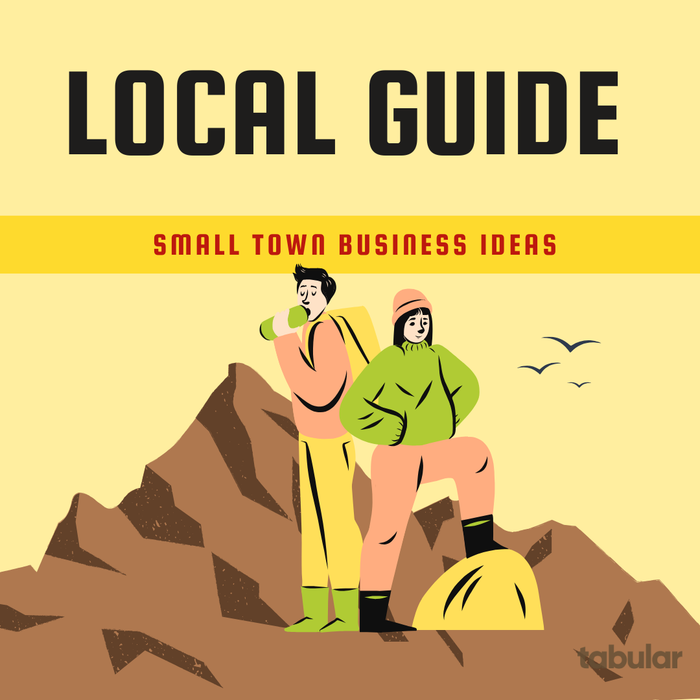
In a small town, this is not a big-bus tour. It's an intimate walking tour. The guide is a storyteller, bringing the town to life in a way a brochure or a self-guided walk never could. You would offer specialized tours like a "Historic Main Street Walking Tour," a "Local Ghost & Legends Tour" (these are extremely popular), or even a "Local Flavors Tour" that includes stops at the town's best bakery, coffee shop, and diner. You are selling a curated experience, providing context and entertainment that makes a tourist's visit memorable and gives locals a new appreciation for their home.
Requirements List:
- Deep, Verifiable Local Knowledge: This is your primary asset. You must be an expert on local history, architecture, interesting trivia, and local legends. This requires dedicated research at the local library, historical society, and by talking to longtime residents.
- A Well-Designed Tour "Product": You need at least one, and preferably two, well-planned tour routes with a practiced script. The tour must have a clear beginning, middle, and end, and be a consistent length (e.g., 90 minutes).
- General Liability Insurance: This is non-negotiable. It protects you financially if a guest trips on a sidewalk and gets injured during your tour.
- An Online Booking System: A simple way for people to see your tour schedule and pay in advance. Services like Eventbrite or FareHarbor are designed for this.
- A Business License and LLC: An LLC is essential to protect your personal assets from business liability.
- Good Storytelling and Public Speaking Skills: You must be able to project your voice, engage a group, and tell stories in a compelling and entertaining way.
How to Start:
- Do Your Research and Develop Your Tour: Spend significant time at the local historical society and library. Uncover interesting, little-known stories. Map out a logical, safe walking route. Write your script and practice it until it sounds natural.
- Practice on Friends and Family: Lead your tour for free for a group of friends. Ask for blunt feedback. Was it boring? Too long? Could they hear you? Refine your tour based on their experience.
- Get Legal and Insured: This is a critical step before taking any paying customers. Form your LLC, open a business bank account, and get your liability insurance policy in place.
- Set Up Your Booking and Pricing: Choose your booking platform. Price your tour competitively but value your expertise (e.g., 20−30 USD per person is a common range).
- Market Through Local Partnerships: This is your key to success.
- Go to every hotel, bed & breakfast, and vacation rental owner. Give them brochures and offer them a small commission for every guest they send you.
- Create a simple website and a Facebook page showing photos from your tours.
- Offer a free "inaugural tour" specifically for local business owners and hotel staff so they know exactly what they are recommending to visitors.
Things to Consider Before (Pitfalls):
- The Weather is Your Boss: Rain, extreme heat, or snow can lead to zero income for the day. You need a clear and fair cancellation/rescheduling policy stated on your website.
- Performance Burnout: Being "on" and telling the same stories with enthusiasm multiple times a day or week is physically and mentally draining. It is a performance, and it can be tiring.
- Low Turnout Risk: What do you do if only one person signs up for a tour? You need a policy for this. Many guides have a "minimum of 2-3 people to run" policy or will offer a private tour for a higher flat rate.
- You Must Justify Your Cost: The main objection is, "Why should I pay you when I can just walk around myself?" Your value proposition is the stories, the curated route, and the entertainment—the things they can't get from Google Maps. You have to sell the experience, not just the walk.
- The Business is Highly Seasonal: Like most tourism businesses, you will be very busy during peak tourist season and very slow in the off-season. You must manage your finances on a yearly cycle, saving money from the good months to cover your fixed costs in the slow ones.
Costs:
- Initial Capital: $500 - $1,500. This is an extremely low-cost business to start. Your only real expenses are business registration (LLC), your first insurance premium, printing some brochures, and setting up a basic website.
- Estimated Profit: Extremely High. This is a pure service business. Outside of your annual insurance premium and minimal marketing costs, nearly all of your revenue is profit. Your inventory is your knowledge.
- Market Growth Rate: Stable. This business's success is directly tied to the health of your town's tourism industry. If your town is a popular place to visit, there will be a steady demand.
- Breakeven: Less than 1 month. Because startup costs are so incredibly low, you can be profitable after leading just a few successful tours. A single good weekend could put you in the black.
29. The Pet Shop
A pet shop is a retail business that sells pet supplies and, sometimes, live animals. The core of the business is providing essential products like high-quality dog and cat food, treats, toys, leashes, collars, beds, and grooming supplies.

In a small town, this business succeeds by being the knowledgeable, local alternative to big-box stores and online retailers like Chewy.com. You cannot compete on price, so you must compete on service, expertise, and community. The pet shop becomes the town's resource for advice on pet nutrition, training aids, and durable toys. A popular and profitable addition is a self-service dog wash station, which provides a unique service that can't be ordered online. The ultimate goal is to become a community hub for pet lovers, often partnering with local shelters for adoption events.
Requirements List:
- Retail Storefront: A physical location with good visibility, parking, and enough space for shelving, a checkout counter, and storage.
- Licenses and Permits: You'll need a standard business license and a sales tax permit. If you sell live animals, you will need specific state and possibly federal (USDA) licenses, which come with strict regulations and inspections.
- Initial Inventory: A curated selection of high-quality pet food, treats, toys, and essential supplies. You'll need to establish accounts with pet supply distributors.
- Point-of-Sale (POS) System: A system to handle sales and, most importantly, to track inventory meticulously. This is critical for managing a retail business.
- Business Insurance: General liability insurance is required. You should also have specific coverage for incidents involving animals on your premises (e.g., a dog bite).
- Deep Product Knowledge: You must be an expert on the products you sell, especially pet nutrition. This expertise is your main advantage over a generic retailer.
How to Start:
- Create a Business Plan and Define Your Niche: This is a capital-intensive business. Your plan must detail startup costs, projected revenue, and your specific angle. Will you be the "all-natural and organic" shop? The "tough toys for farm dogs" shop? Define your focus.
- Secure Funding and a Location: With your business plan, secure a small business loan. Simultaneously, find and lease a suitable retail space.
- Get Legal and Licensed: Form your LLC, open a business bank account, and obtain all necessary local and state permits. Decide early if you will sell live animals and begin that complex licensing process immediately. The simplest and most ethical way to start is to not sell animals and instead partner with local rescues.
- Establish Supplier Accounts: Contact pet supply distributors to set up wholesale accounts. Order your initial inventory, focusing on a strong selection of your chosen niche products.
- Set Up Your Store: Install shelving, set up your POS system, and arrange your products in an organized, appealing way. If you are including a self-service dog wash, complete its construction.
- Market Your Grand Opening: Build anticipation on a local Facebook page. Post "coming soon" signs. Plan a grand opening event, perhaps featuring a local animal rescue with adoptable pets. This immediately establishes you as a community-focused business.
Things to Consider Before (Pitfalls):
- Competition from Online Retailers (The Chewy.com Problem): This is your biggest challenge. Customers can get food cheaper and delivered to their door. You win with immediate availability (for someone who just ran out of food), expert advice, a unique in-store experience, and services like a dog wash.
- Inventory Management is Difficult: Pet food expires. Some toys will be duds and sit on the shelf for a year. It is very easy to tie up all your cash in dead stock. A good POS system and disciplined ordering are essential to survival.
- The Ethical Burden of Live Animals: Selling live animals is a huge responsibility. It involves sourcing them from reputable breeders (avoiding puppy mills), providing proper vet care, and finding a plan for animals that don't sell. It is often a low-margin, high-headache part of the business that can damage your reputation if done poorly.
- High Overhead Costs: The combination of monthly rent and the constant cost of inventory means you have high overhead. You need consistent daily sales to cover costs and turn a profit, which can be difficult in a small town.
- You're an Unofficial Pet Counselor: You will be on the front lines of your customers' lives with their pets. You will share in the joy of a new puppy and be a shoulder to cry on when a beloved 15-year-old dog passes away. This can be emotionally taxing but is also part of building a true community business.
Costs:
- Initial Capital: $25,000 - $75,000+. This is a high-cost startup. The primary expenses are lease deposits, store build-out (shelving, counters), the POS system, and—most significantly—the cost of your entire initial inventory.
- Estimated Profit: Low to Medium. Margins on pet food are notoriously thin. Profitability depends on selling higher-margin items like treats, toys, and accessories, as well as driving traffic through high-margin services like a self-service dog wash.
- Market Growth Rate: Stable. The pet industry is famously recession-resistant. People consistently spend money on their pets, creating a very steady market.
- Breakeven: 24 - 48 months. Due to the high startup costs and thin margins on core products, it takes a long time to recoup the initial investment. This is a long-term business, not a quick moneymaker.
30. The Professional Home Painter
A professional home painter provides interior and exterior painting services for residential properties. Its purpose is to refresh, protect, and increase the value of a client's home through skilled paint application. This includes all phases of the work: surface preparation (sanding, cleaning, patching), priming, painting, and detailed cleanup.

In a small town, this business thrives on reputation and trust. Homeowners prefer hiring a known, local individual they can rely on over a large, anonymous company from out of town. The work is constant; houses always need painting, whether it's a single bedroom, a whole interior, or a full exterior job to protect it from the elements. Your success depends not just on your painting skill, but on your reliability, neatness, and the good word that spreads from one happy neighbor to the next.
Requirements List:
- General Liability Insurance: This is absolutely mandatory. It protects you and the client if you accidentally spill paint on an expensive floor, break a window, or if a ladder falls and damages property.
- Professional-Grade Equipment:
- Ladders: A variety of high-quality, safe ladders (step ladders, extension ladders).
- Prep Tools: Sanders, scrapers, putty knives, caulk guns, drop cloths, and lots of painter's tape.
- Application Tools: High-quality brushes, rollers, paint trays, and an airless paint sprayer (for efficiency on larger jobs).
- A Reliable Vehicle: A truck or van is necessary to transport ladders, tools, and supplies.
- Painting Skill and Knowledge: This is a skilled trade. You must know how to properly prep different surfaces, how to "cut in" a straight line, and which type of paint to use for different applications (e.g., bathroom vs. exterior siding).
- A Detailed Quoting System: A professional template for providing written estimates that clearly breaks down the scope of work, including prep, number of coats, and the specific paint to be used.
- Business License and LLC: An LLC is crucial to protect your personal assets from the high liability risks of working on someone's property.
How to Start:
- Gain Experience: The best way to start is by working for another professional painter for a season. This teaches you the trade, speed, and business practices without risking your own money. Alternatively, perfect your skills on your own home and the homes of friends or family.
- Get Legal and Insured: Before you seek your first paid job, form your LLC, open a business bank account, and get your liability insurance policy. Do not skip this step.
- Buy Your Essential Equipment: Invest in quality tools. Good brushes and a sturdy ladder are safer and produce better results. You can start without an expensive sprayer and rent one if needed for a big job.
- Develop Your Quoting Process: Create a detailed quote sheet. When you estimate a job, be thorough. Measure the space and specify what is included (e.g., "patching all nail holes," "two coats of Sherwin-Williams paint on all walls"). This prevents disputes later.
- Find Your First Jobs: Your first clients will come from word-of-mouth. Let everyone you know that you are starting a painting business. Give a stack of business cards to the paint counter at the local hardware store. Network with local real estate agents who need houses painted before they are sold.
Things to Consider Before (Pitfalls):
- Under-Quoting is a Business Killer: This is the most common mistake. New painters forget to factor in the huge amount of time spent on prep work, cleanup, and travel. If you only estimate the time you'll have a brush in your hand, you will lose money.
- Prep Work is 80% of the Job: The actual painting is the easy part. Clients may not understand why it takes a full day just to prep a room. You must educate them that a perfect finish comes from meticulous prep (sanding, patching, taping, cleaning).
- The Weather Rules Exterior Work: For exterior painting, rain, wind, or high humidity can shut down your operation for days, destroying your schedule and cash flow. You cannot work around bad weather.
- It's Physically Brutal Work: Painting is tough on the body. It involves constant reaching, bending, and climbing. It's repetitive and can lead to back, shoulder, and wrist strain.
- You Are a Guest in Someone's Home: You must be incredibly respectful and neat. Protecting a client's furniture, floors, and belongings is just as important as the paint job itself. A single paint drip on an unprotected heirloom can ruin your reputation.
Costs:
- Initial Capital: $2,000 - $5,000. This is a relatively low-cost business to start. The main expenses are high-quality ladders, a basic set of professional tools, a significant down payment on your insurance policy, and business registration fees. The client typically pays for the paint itself as a job cost.
- Estimated Profit: High. As a service business, your main cost is your labor. Once you have your equipment, ongoing costs are low (consumable supplies like tape, rollers, and gas). A large percentage of the price of a job is your profit.
- Market Growth Rate: Stable. Home maintenance is a constant need. There is a steady, predictable demand for good painters in any community.
- Breakeven: 1 - 3 months. With low startup costs, one or two good-sized jobs (like a full interior) are often enough to pay back your initial investment and become profitable.
31. The Vending Machine Operator
A vending machine operator owns, places, stocks, and services machines that sell snacks and drinks. This is not a retail business where customers come to you; instead, you take your "store" to where the customers already are. You make money from the accumulated small profits on each item sold.
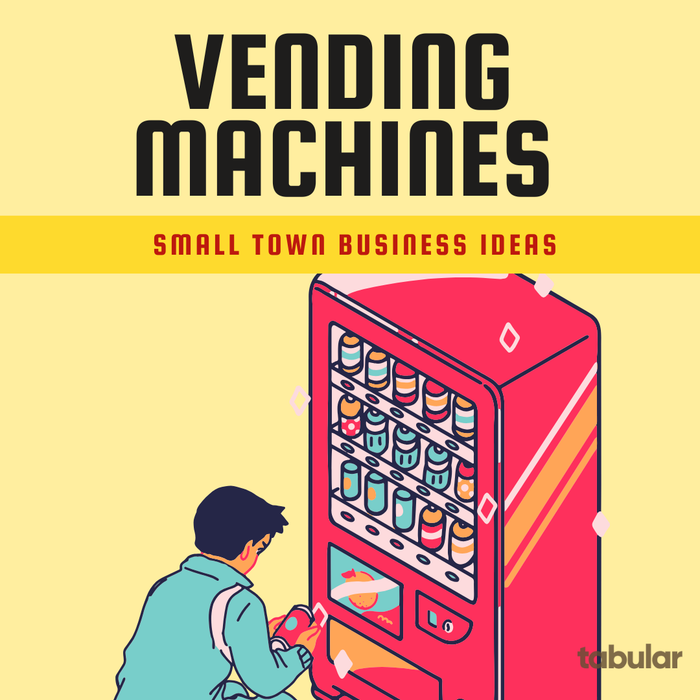
In a small town, this business thrives by providing convenience in places that don't have a nearby store or cafeteria. Your machines serve a captive audience. Prime locations include break rooms at small manufacturing plants, auto mechanic waiting areas, the local laundromat, community centers, schools, and even motels. You offer the location owner a zero-cost, zero-effort amenity for their employees or customers, while you handle all the work of stocking, service, and cash collection.
Requirements List:
- Vending Machines: You will need at least one reliable machine. Combo machines (snacks and drinks) are a great starting point. You can buy new, but most operators start with quality used or refurbished machines.
- A Suitable Vehicle: A van, SUV, or truck is necessary to transport stock and tools.
- Inventory Storage Space: A clean, dry place in your home, like a garage or basement, to store your backstock of chips, candy, and drinks.
- A Location Agreement: A simple, written contract with the owner of the business where you place your machine. This should specify that you own the machine, are responsible for it, and outlines any commission you might pay them (often 0-10%).
- Sales Tax Permit: You are a retailer, so you must collect and remit sales tax.
- Business License and LLC: An LLC is essential to protect your personal assets.
- Basic Tools and Cash Handling Supplies: Wrenches for leveling machines, cleaning supplies, and a system for counting and rolling large amounts of coins.
How to Start:
- Find a Location First: This is the most important step. Do not buy a machine until you have a confirmed place to put it. Walk into local businesses that have steady foot traffic and no food service. Pitch the owner on the benefit: a free amenity for their staff/customers that you manage entirely.
- Get Legal and Secure the Agreement: Once you have a verbal "yes" from a location, form your LLC, get your sales tax permit, and have the business owner sign your location agreement.
- Buy Your First Machine: Now that you have a home for it, purchase your machine. Search for local vending operators selling used equipment or look on marketplaces like Facebook and Craigslist.
- Buy Initial Inventory: Go to a bulk store like Sam's Club or Costco and purchase a variety of popular brand-name snacks and drinks. Start with a small, diverse inventory until you learn what sells in that specific location.
- Place and Stock the Machine: Transport the machine to the location, set it up, level it, and stock it fully. Make sure it is clean and everything is working perfectly.
- Establish a Service Schedule: Create a regular route for yourself. To start, check on the machine weekly to restock popular items, collect cash, and ensure it is clean and operational.
Things to Consider Before (Pitfalls):
- Location is 100% of Your Success: A machine in a bad location with no foot traffic will not make money. It will just be a large, expensive paperweight. Finding good, profitable locations is the hardest and most important part of the job.
- This is NOT Passive Income: This business is often marketed as "passive," but it's not. It's a part-time job that requires driving, lifting heavy cases of soda, tracking inventory, counting money, cleaning machines, and troubleshooting mechanical issues.
- Mechanical Failures: Vending machines break. Bill validators will jam, and coin mechanisms will fail. You need to be comfortable doing basic troubleshooting and repairs yourself, or your machine will have downtime and lose sales.
- Inventory is a Guessing Game at First: You will make mistakes. The candy bars you think will be a hit will expire on the shelf, while the chips you thought were a long shot sell out in two days. You must pay close attention to sales data to optimize your product mix.
- Vandalism and Theft: A machine in a publicly accessible, unsupervised area is a target for vandalism or break-ins. You must assess this risk for every location.
Costs:
- Initial Capital:
- One quality used vending machine: $1,000 – $3,000
- Initial product inventory: $300 – $500
- Estimated Profit: Low to Medium per machine. Profit depends heavily on volume. A single machine might generate only $50 – $150 in profit per month. The business becomes more profitable as you scale up and place multiple machines in high-traffic locations.
- Market Growth Rate: Stable. There is consistent demand for convenient snacks and drinks. This is a mature industry with minimal fluctuations or innovation.
- Breakeven Period: 18 – 36 months per machine. This is a slow-and-steady business model. Small daily profits accumulate over time, gradually repaying the initial investment.
32. The Dry Cleaner
A dry cleaner is a retail service that cleans clothing and textiles using chemical solvents instead of water. This process is essential for delicate fabrics like wool, silk, and rayon that would be damaged by a normal washing machine. The business includes not just cleaning, but also professional pressing, steaming, and often services like minor alterations and wedding dress preservation.

In a small town, the dry cleaner is an essential infrastructure service. It is the only place for residents to care for their most important garments: suits for work, dresses for prom and weddings, and uniforms for local organizations. It operates on a routine of drop-off and pickup, becoming a regular stop for many in the community. Trust is the foundation of the business; customers leave their expensive and sentimental items in your care, relying on your professionalism to return them in perfect condition.
Requirements List:
- Commercial Dry-Cleaning Machine: The core of the business. These use specific chemical solvents (newer, eco-friendly options are available but more expensive).
- Professional Pressing Equipment: A variety of steam presses (for pants, shirts, etc.), puff irons, and a spotting board for pre-treating stains.
- Commercial Boiler: To generate the large amounts of steam needed for pressing.
- A Suitable Commercial Space: Must have proper ventilation, industrial-grade plumbing for a boiler, and often 3-phase electrical power.
- Environmental Permits: Due to the use of chemicals, you will need specific state and potentially federal (EPA) permits for chemical use, storage, and disposal. This is a complex and mandatory step.
- Specialized Insurance: Beyond general liability, you will likely need Pollution Liability Insurance to cover potential chemical spills or environmental contamination.
- Garment Tracking System: A point-of-sale (POS) system designed for dry cleaners that uses tags to track every single garment from drop-off to pickup to prevent lost items.
- Skilled Labor: You need a skilled presser and a "spotter" who knows how to identify and treat different types of stains. This is a trade, not an unskilled position.
How to Start:
- Option A (Recommended): Buy an Existing Business: This is the most common and wisest path. You acquire the incredibly expensive equipment, the properly zoned location, the necessary permits, and the existing customer base all at once. Before buying, conduct thorough due diligence, including professional equipment inspections and a review of the business's environmental compliance history.
- Option B (Very Difficult): Start from Scratch: This is a massive undertaking. You would need to secure significant funding (likely an SBA loan), find a location that can be retrofitted, navigate the complex environmental permitting process, purchase and install tens of thousands of dollars in equipment, and then build a customer base from zero.
- Get Legal and Insured: Whether buying or starting new, form an LLC immediately to protect your personal assets. Secure all necessary insurance policies, especially pollution liability, before opening your doors.
- Hire and Train a Skilled Team: Find an experienced presser. This skill is critical for quality and speed. A good presser is the heart of the operation.
- Market by Building Trust: Your best marketing is your reputation. Do perfect work, never lose an item, and be friendly and reliable. Your business will grow through word-of-mouth. Introduce yourself to owners of local B&Bs and funeral homes, as they often have a need for your services.
Things to Consider Before (Pitfalls):
- Extreme Environmental Liability: This is the single biggest risk. A chemical spill or improper disposal can lead to soil contamination and cleanup costs that can exceed the value of the business and bankrupt you. Compliance is not optional.
- Massive Capital and Overhead Costs: The initial investment is huge. Furthermore, your monthly utility bills (gas, water, electricity for the boiler and machines) and insurance premiums are very high. You need a high volume of daily customers just to cover your costs.
- The Risk of Ruining Expensive Clothes: One mistake can destroy a customer's $1,000 suit or irreplaceable wedding dress. This can ruin your reputation in a small town overnight. You must have a clear policy for handling damage claims.
- Finding Skilled Labor is Extremely Difficult: The number of people who know how to properly spot-treat and press clothing is shrinking. Finding and retaining a good, experienced presser will be one of your biggest ongoing challenges.
- Changing Fashion Trends: The rise of "business casual" and advances in wash-and-wear fabrics mean that people require dry cleaning less frequently than they did 20 years ago. The overall market is mature and not growing.
Costs
- Initial Capital: $50,000 – $500,000+
- Low End ($50,000 – $100,000): If you are able to find and purchase a small, existing business.
- High End ($200,000 – $500,000+): If you must start from scratch, build out a location, and buy all new equipment.
- Estimated Profit: Medium. While you can charge a premium for the service, the high costs of labor, utilities, supplies, and insurance keep profit margins in check. Profitability depends entirely on maintaining high volume.
- Market Growth Rate: Declining to Stable. The national market is slowly declining. In a small town where you are the only provider, your market may remain stable but is unlikely to grow significantly.
- Breakeven Period: 3 – 7 years. Due to the large initial investment and significant overhead, this is a long-term business. It takes several years of consistent operation to recover the startup costs.
33. The Daycare Center / In-Home Daycare
A daycare provides licensed, structured care for infants, toddlers, and preschool-aged children. This is an essential service, not just babysitting. It involves creating a safe environment, planning age-appropriate educational activities, and managing the daily needs of multiple children.

In a small town, a daycare is a critical piece of the local economy. It allows parents to go to work, knowing their children are in a safe and enriching environment. There are two primary models:
In-Home Daycare: A licensed provider cares for a small group of children in their own modified and inspected home. This is the most common and accessible model in a small town.
Daycare Center: A larger, commercial facility that can accommodate more children and staff, often separating children into different age groups.
The business succeeds by building deep trust with local families. It often becomes the first "school" experience for children and a vital community hub for parents.
Requirements List:
- STATE CHILDCARE LICENSE: This is the #1, non-negotiable requirement. It is a complex process involving extensive background checks (for you and anyone else living in the home), facility inspections, health and safety training, and adherence to strict regulations.
- A Suitable and Safe Space: For an in-home daycare, this means a child-proofed home with a securely fenced outdoor play area. For a center, it means a commercial building that meets zoning and safety codes (fire exits, specific bathroom requirements, etc.).
- Massive Liability Insurance: Standard business insurance is not enough. You need a specific, high-limit policy designed for childcare providers. This will be a significant operating cost.
- Qualified Staff (and Ratios): Your state license will mandate strict staff-to-child ratios (e.g., one adult per four infants). All staff must have CPR/First Aid certification and pass background checks.
- Parent Contracts and a Policy Handbook: A lawyer should review your contract and handbook. It must clearly outline your hours, tuition rates, late pickup fees, illness policy, and termination procedures.
- Age-Appropriate Equipment: All toys, cribs, highchairs, and learning materials must be safe, clean, and appropriate for the ages you serve.
How to Start:
- Contact Your State's Childcare Licensing Agency: This is your first and most important step. Do not spend a single dollar until you have the full checklist of state requirements. Understand the entire process, costs, and timeline.
- Create a Detailed Business Plan: Determine your model (in-home or center). Calculate your startup costs, set your tuition rates by researching the local market, and project your monthly expenses (especially payroll and insurance). This plan is essential for getting a loan if you need one.
- Get Legal and Insured: Form your LLC to protect your personal assets. Secure your childcare liability insurance policy. Open a separate business bank account.
- Prepare Your Physical Space: This is where you complete all the safety modifications required by the state license. Purchase and set up all your furniture, toys, and supplies.
- Pass Your Licensing Inspection: Schedule your final inspection with the state licensing agency. They will give you the official approval to operate.
- Market and Enroll: Start a Facebook page to show off your new, clean, and safe space. Your best marketing in a small town is word-of-mouth. Announce that you are opening and start a waitlist. Demand is often so high that you may be full before you even open.
Things to Consider Before (Pitfalls):
- Licensing is a Monumental Hurdle: The process is deliberately difficult, bureaucratic, and slow to ensure child safety. It can be a frustrating and expensive barrier to entry. Do not underestimate it.
- The Liability is Immense: You are responsible for the health and safety of other people's children. The emotional and financial weight of this responsibility is enormous. One serious accident can lead to devastating lawsuits and the end of your business.
- Finding and Keeping Good Staff is a Crisis: The childcare industry is known for low pay and high stress, leading to extremely high staff turnover. Finding qualified, reliable, and caring staff—and paying them enough to stay—will be your single biggest operational challenge.
- Emotional and Physical Burnout is Real: This is an incredibly demanding job. It involves long hours, constant noise, cleaning up messes, and managing the emotions of both children and parents. It is physically and emotionally draining.
- Illness is a Constant Battle: Children are a petri dish for germs. You, your staff, and the children will get sick often. Your illness policy must be firm and consistently enforced to prevent constant outbreaks.
Costs:
- In-Home Model: $3,000 - $10,000. Costs are for licensing fees, safety upgrades to your home, toys/equipment, and your first major insurance payment.
- Center Model: $40,000 - $150,000+. Costs are dramatically higher, involving commercial lease deposits, major renovations, and a huge amount of equipment.
- Estimated Profit: Low. This is a passion-driven business, not a get-rich-quick scheme. Margins are very thin due to the high costs of labor (to meet ratios) and insurance. Profitability depends entirely on maintaining full enrollment.
- Market Growth Rate: High. Most small towns are considered "childcare deserts" with far more demand than supply. If you can get licensed, you will have customers.
- Breakeven: 1 - 5 years. An in-home model with low startup costs can be profitable within a year or two. A large center with high debt will take many years to break even.
34. The Beauty Salon
A beauty salon is a retail establishment that provides professional hair care services, including cutting, styling, coloring, and chemical treatments. Many salons also expand to offer nail services (manicures/pedicures), waxing, and basic skincare.
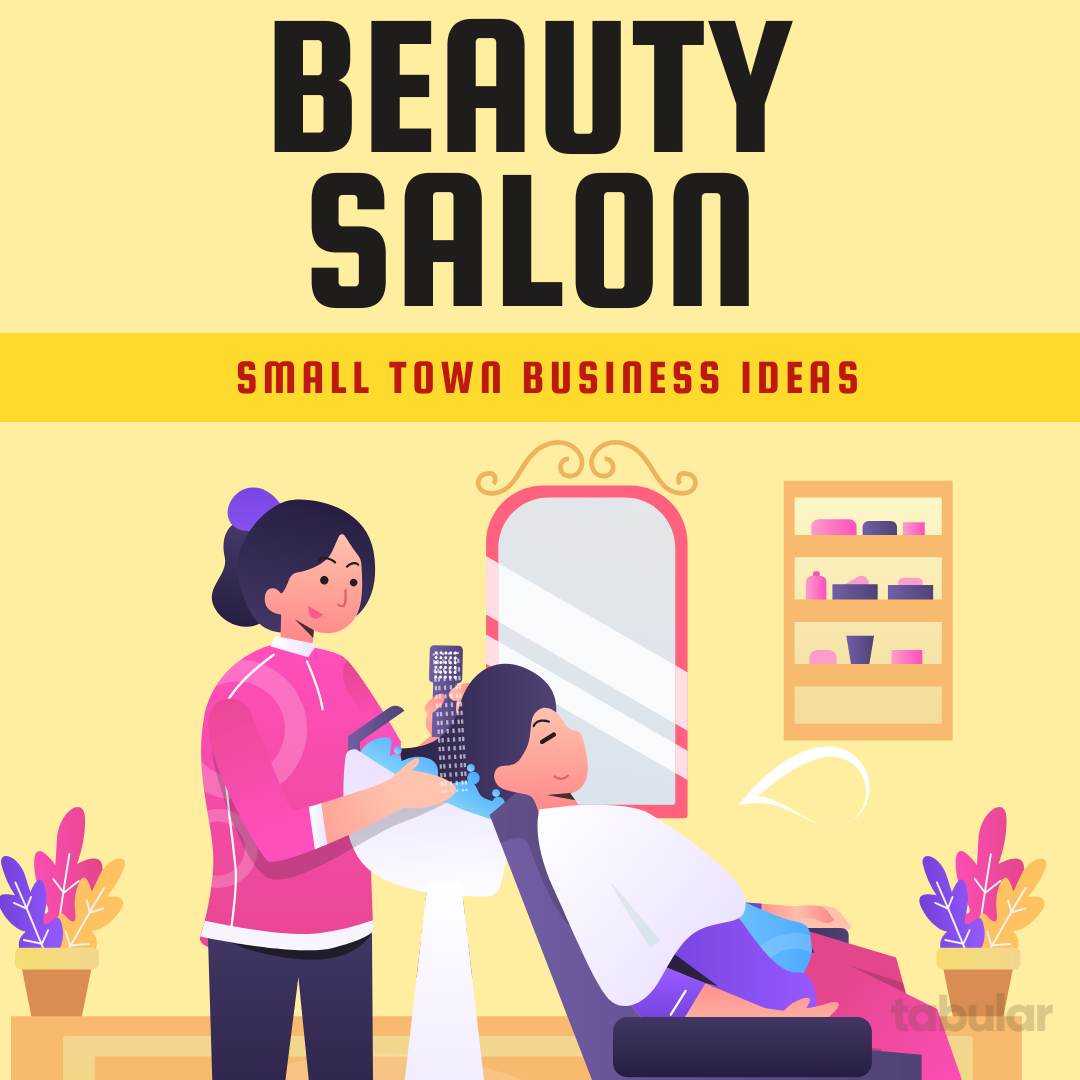.png?w=700&fit=max&auto=format)
In a small town, a salon is a social and community institution. It's where people go for their weekly appointment, to get ready for major life events like proms and weddings, and to catch up on local news. Trust and loyalty are everything; clients often stay with the same stylist for decades. The business typically operates in one of two ways: either the owner hires stylists as employees, or they operate a "booth rental" model where independent, licensed stylists pay the owner a flat weekly or monthly fee to use a chair and facilities.
Requirements List:
- State Cosmetology / Establishment License: This is the most important legal requirement. The business owner must have a salon license from the state's Board of Cosmetology, and every single person providing services must hold a current, valid personal cosmetology (or nail tech, etc.) license.
- A Suitable Commercial Space: The location must meet state board regulations, which often include specific plumbing for shampoo bowls, adequate ventilation for chemical services, and specific standards for sanitation.
- Professional Equipment: Styling stations (chair, mirror, counter space), Shampoo bowls and chairs, Hooded dryers, Professional tools (clippers, shears, brushes, blow dryers), A dispensary area for mixing color
- Professional Liability Insurance: This is non-negotiable. It covers you in case of accidents, like a client having an allergic reaction to a chemical or damage to their hair.
- Inventory: A professional "backbar" (shampoos, conditioners, color) for use during services, and a separate inventory of retail products for clients to purchase.
- Point-of-Sale (POS) and Booking System: A modern system (like Square, GlossGenius, or Vagaro) to manage appointments, client information, and process payments.
How to Start:
- Get Licensed and Gain Experience: First, you must have your personal cosmetology license. The crucial next step is to work in another salon for several years. This is where you build your skills and, most importantly, a loyal list of clients who will follow you when you open your own place.
- Choose Your Business Model (Booth Rental vs. Employee): Decide early if you want the steady, lower-maintenance income of renting booths or the higher profit potential (and higher management burden) of hiring employees.
- Create a Business Plan and Secure Funding: Calculate the significant startup costs for equipment and renovations. Use this plan to secure a small business loan.
- Find a Location and Get it Approved: Find a suitable space and, before signing a lease, confirm with the state board that it can be approved as a salon.
- Get Legal and Insured: Form your LLC, open a business bank account, get your salon establishment license, and secure your professional liability insurance.
- Purchase Equipment and Stock: Buy your styling stations, shampoo bowls, and other major equipment. Establish accounts with professional beauty suppliers (like SalonCentric or Cosmoprof) and purchase your initial backbar and retail inventory.
- Recruit Stylists / Market Your Opening: If you're a booth rental salon, start recruiting other local stylists. Announce your opening on Facebook and directly to your personal client list.
Things to Consider Before (Pitfalls):
- Your Income is Tied to Your Hands: If you aren't physically behind the chair working, you aren't making money (unless you have booth renters or employees). Vacations, sick days, and slow periods directly impact your income.
- The Booth Rental vs. Employee Dilemma: This is a huge decision. With booth renters, you have less control over the salon's culture and quality, but it's stable income. With employees, you have more control and profit potential, but you are responsible for payroll, taxes, training, and management.
- Salon Drama is Real: Managing the personalities and conflicts between different stylists (or even clients) can be a major source of stress and can poison your salon's atmosphere.
- It is Physically Demanding: This job involves being on your feet all day, repetitive motions that are hard on your hands, wrists, and shoulders, and constant exposure to chemicals.
- You Must Constantly Evolve: Hair and beauty trends change rapidly. You must invest your own time and money in continuing education classes to learn new techniques and stay relevant, otherwise your clients will go elsewhere.
Costs:
- Renting a Booth (in another salon): $1,000 - $3,000. This is the leanest way to start, covering your personal tools, insurance, and first month's rent.
- Opening a Salon: $20,000 - $75,000+. This is a moderate to high-cost startup. Costs include lease deposits, plumbing and electrical work, salon equipment, and initial inventory.
- Estimated Profit: Medium to High. A solo operator has very high profit margins. A salon owner's profit depends on keeping chairs filled with clients or renters. High-margin retail sales are a key source of additional profit.
- Market Growth Rate: Stable. People always need haircuts. This industry is famously recession-resistant and provides a steady, reliable demand.
- Breakeven(Booth Renter): 1 - 3 months.
- Breakeven(Salon Owner): 2 - 5 years. It takes significant time to pay back the high initial investment in equipment and renovations.
35. The Souvenir & Local Gift Shop
A souvenir shop is a retail business focused on selling items that commemorate a visitor's experience in a specific location. However, in a small town, this business must evolve beyond cheap trinkets to survive. It should be a curated "local gift shop" that celebrates the town's unique character.

Your shop becomes the town's brand ambassador. You sell quality apparel with the town's name or logo, postcards featuring local landmarks, and products made by local artisans (pottery, woodworking, art prints). It's also the place for locally produced foods like honey, jams, or coffee beans. This model serves two customer bases: tourists looking for an authentic memento, and locals looking for a unique gift that represents their hometown.
Requirements List:
- A High-Foot-Traffic Retail Location: This is essential. The shop must be located in the heart of the downtown area or wherever tourists congregate. Visibility is key.
- A Point-of-Sale (POS) System: A system to handle sales, process credit cards, and, most importantly, track inventory.
- Initial Inventory: A curated mix of products. This includes both custom-designed items (T-shirts, mugs) and goods sourced from local makers.
- Relationships with Local Makers and Suppliers: You need to actively find and build relationships with local artists, craftspeople, and food producers to source unique products.
- Business Insurance: General liability and property insurance to cover your store and inventory.
- Sales Tax Permit and Business License: Standard requirements for any retail operation.
- Store Fixtures: Shelving, display tables, a cash wrap/checkout counter, and good lighting.
How to Start:
- Source Your Products First: Before you even look for a location, figure out what you will sell. Can you find enough local artisans? Can you find a good screen printer for custom T-shirts? Your product mix is your business plan.
- Create a Business Plan: Detail your target customers (tourists, locals), your unique product strategy, and your financial projections. Calculate your startup costs, especially the high cost of initial inventory.
- Find a Location and Secure Funding: With your plan, secure a small business loan if needed. Find and lease the best possible retail spot you can afford.
- Get Legal and Licensed: Form your LLC, open a business bank account, and get your sales tax permit and any other local licenses.
- Set Up Your Store and Order Inventory: Purchase and install your store fixtures. Place your first large orders for inventory. This will be your biggest single expense.
- Market Through Partnerships: Your success is tied to tourism. Introduce yourself and your shop to every hotel manager, B&B owner, and tour guide in town. Give them a stack of your business cards or postcards. They are your primary referral source.
Things to Consider Before (Pitfalls):
- Seasonality is Your Biggest Enemy: You will likely make most of your money during a few peak tourist months. You must be extremely disciplined with your finances to save enough cash from the busy season to cover your rent and expenses during the dead of winter.
- Inventory is a Cash Trap: This is the classic retail killer. It is very easy to spend all your money on inventory that doesn't sell. Start with a smaller, curated selection and use your POS data to see what's popular before you reorder.
- Avoiding the "Tacky" Trap is Essential: Your value is in being a quality local gift shop, not a cheap junk shop. Avoid filling your shelves with generic, mass-produced items from a catalog. Your curation and local focus are your only defense against online shopping.
- Competition Can Be Unexpected: Your competition might not be another gift shop. It might be the local pharmacy with a postcard rack, the hardware store that sells branded hats, or the art gallery. You need to be the clear destination for this specific need.
- You Must Be a Salesperson: This is not a passive job where you just stand behind a counter. You need to be actively engaging with customers, telling the story behind the local products, and helping them find the perfect item.
Costs:
- Initial Capital: $15,000 - $50,000. This is a moderate to high-cost startup. The main expenses are lease deposits for a prime retail location, store fixtures, and the large upfront cost of your entire initial inventory.
- Estimated Profit: Medium. Retail profit margins are solid but not as high as a pure service business. Profitability is entirely dependent on achieving high sales volume during the peak season and carefully managing your inventory costs.
- Market Growth Rate: Stable. Your growth is directly tied to your town's tourism industry. If your town becomes a more popular destination, your business can grow with it.
- Breakeven: 24 - 36 months. Due to the high initial inventory cost and the seasonal nature of the business, it typically takes at least two full tourist seasons to recoup your initial investment and become consistently profitable.
36. The Pool Maintenance Service
A pool and spa service business provides routine maintenance, cleaning, and chemical balancing for residential swimming pools and hot tubs. The core service is a weekly visit where the technician skims debris, brushes the pool walls, vacuums the floor, empties baskets, and tests and adjusts the water chemistry to keep it safe and clear. This is a service-based business built on creating a reliable route of recurring clients.
.png?w=700&fit=max&auto=format)
In a small town, this business is a sought-after luxury service. Homeowners with pools often lack the time, expertise, or desire to do the constant, necessary maintenance themselves. They are willing to pay a monthly fee for the convenience and peace of mind of having their pool professionally cared for and always ready to use. You are selling back their free time and ensuring their expensive asset is protected and safe for their family.
Requirements List:
- A Reliable Truck: This is non-negotiable. You need it to haul chemicals, long poles, and equipment from job to job. A professional, clean truck is also a key part of your marketing.
- Professional-Grade Equipment: This includes a high-quality telescoping pole, skimmer nets, wall brushes, a pool vacuum head and hose, and a commercial-grade water testing kit (not cheap test strips).
- Initial Stock of Chemicals: A starting supply of bulk chemicals like liquid chlorine, chlorine tablets, muriatic acid, soda ash, and algaecide.
- General Liability Insurance: Mandatory. This protects you if you accidentally damage a client's pool equipment or property, or if your chemical balancing leads to an issue.
- Certified Pool Operator (CPO) Certification: While not legally required in all states, this is the industry standard. It proves your expertise, teaches you critical safety information, and is a huge factor in gaining client trust and satisfying insurance requirements.
- A Scheduling System: A way to efficiently manage your weekly route. This can be a simple app or even a spreadsheet to start.
How to Start:
- Get Certified and Educated: Before you do anything else, get your CPO certification. This is the foundation of your professional knowledge and credibility.
- Get Legal and Insured: Form your LLC to protect your personal assets. Open a business bank account. Get your liability insurance policy in place. Do not service a single pool for pay without insurance.
- Buy Your Professional Equipment: Purchase your truck, tools, and initial chemical supply. Investing in quality tools will save you time and make you look more professional.
- Develop Your Pricing: Research the going rate in your area. Pool service is typically charged as a flat monthly fee for weekly service (e.g., 150−250 USD per month). Create a simple service agreement that outlines exactly what your weekly service includes.
- Find Your First Clients: Your first clients are your best marketing. Start with your own pool or a friend's to take before/after photos. Give business cards to local pool supply stores and real estate agents (who work with new homeowners). A clean truck with a professional magnetic sign is a powerful local advertisement.
Things to Consider Before (Pitfalls):
- Seasonality Can Kill Cash Flow: In most parts of the country, this is a 6-8 month business. You must charge enough during the busy season to save and cover your expenses during the slow winter months. Some operators add off-season services like holiday light installation to compensate.
- Underpricing is a Common Failure: New operators forget to factor in the high cost of gas, vehicle maintenance, insurance, and the ever-increasing price of chemicals. Your monthly fee must cover much more than just your time at the property.
- The Weather is Your Enemy: You have to work outside in the extreme heat of summer. A week of heavy rain can throw off your entire schedule and your pools' chemical balance, creating extra work.
- Liability is Always a Risk: You are dealing with chemicals and water safety. If a child gets sick from improperly balanced water, you could be held liable. Your CPO training and meticulous record-keeping are your best defense.
- You Will Find Problems You Can't Fix: You will discover broken pumps, leaking filters, or torn liners. You must decide if you will learn how to do these basic repairs (a huge value-add) or if you will build a relationship with a trusted repair specialist for referrals.
Costs:
- Initial Capital: $3,000 - $8,000. This assumes you already have a truck. The costs cover professional tools, an initial stock of chemicals, LLC registration, insurance down payments, and CPO certification fees. If you need to buy a truck, the cost will be significantly higher.
- Estimated Profit: High. Once you have a full route, this is a very profitable business. Your main ongoing costs are chemicals and gas, which are a relatively small fraction of your monthly service fees. The majority of the revenue is your profit.
- Market Growth Rate: Stable. The number of residential pools is steady or slowly growing. The demand for reliable service is constant.
- Breakeven: 2 - 6 months. With a low initial investment (if you have a truck) and recurring monthly revenue, you can become profitable very quickly once you build a route of 10-15 clients.
37. Accountant / Bookkeeper
This business provides essential financial services to other small businesses and individuals. It operates on two levels:
Bookkeeping: The day-to-day work of recording all financial transactions (sales, expenses), reconciling bank accounts, and generating basic financial reports. This is the foundation of financial health.
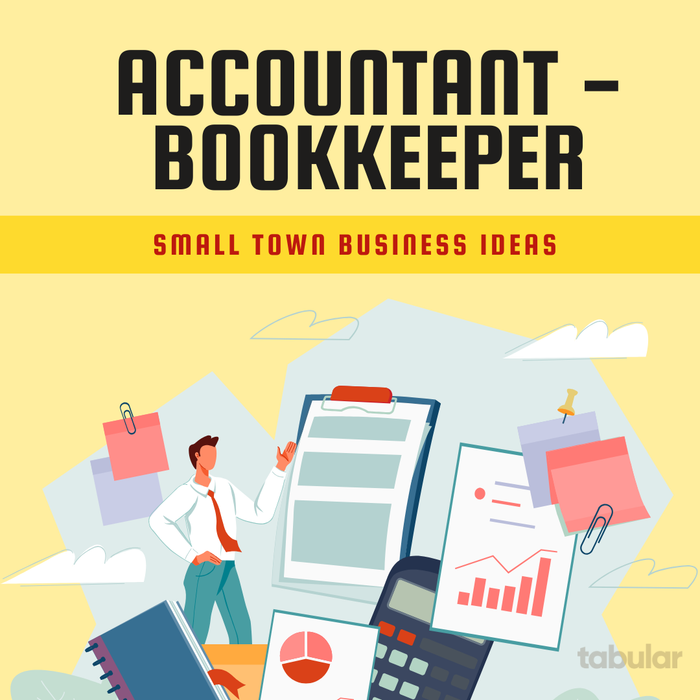
Accounting: The higher-level service of preparing tax returns, providing financial advice, and helping business owners understand their numbers to make strategic decisions.
In a small town, you are the financial backbone for Main Street. You are the trusted advisor to the plumber, the salon owner, and the local diner. They are experts in their trade, not in tax law or financial statements. You provide the clarity and compliance they need, freeing them up to run their business. Your value is not competing with TurboTax; it's providing local, personalized expertise and building long-term, trusted relationships.
Requirements List:
- CPA (Certified Public Accountant): The gold standard. Required for signing tax returns with the highest level of authority and performing audits. This requires extensive education and passing a difficult exam.
- EA (Enrolled Agent): A tax specialist licensed directly by the IRS. A highly respected credential focused entirely on tax preparation and representation.
- Certified Bookkeeper: For a bookkeeping-only business, certifications like a QuickBooks Online ProAdvisor are the industry standard and demonstrate your competence on the primary software platform.
- Errors & Omissions (E&O) Insurance: This is absolutely mandatory. It protects you financially if a mistake you make costs a client money (e.g., a tax miscalculation that results in penalties).
- Accounting and Tax Software: A subscription to professional accounting software (QuickBooks Online Accountant is the standard) and professional tax preparation software.
- PTIN (Preparer Tax Identification Number): Required by the IRS for anyone who prepares federal tax returns for compensation.
- A Secure System for Client Documents: A secure client portal or encrypted file-sharing service to handle sensitive financial information.
- Business License and LLC: An LLC is essential to protect your personal assets from business liability.
How to Start:
- Get Your Credentials: This is step zero. Pass the CPA or EA exam, or complete your bookkeeping certification. Your knowledge and credentials are your product.
- Define Your Services and Niche: Will you focus on tax preparation only? Or offer year-round monthly bookkeeping? It's often smart to specialize in a few local industries you understand, like construction trades or retail businesses.
- Get Legal, Insured, and Registered: Form your LLC, open a business bank account, buy your E&O insurance policy, and get your PTIN from the IRS.
- Set Up Your Tech Stack: Get your QuickBooks Online Accountant account and learn it inside and out. Set up your secure client portal.
- Create Your Service Packages: Don't just sell by the hour. Create flat-fee monthly packages (e.g., "Monthly Bookkeeping & Payroll," "Quarterly Tax Planning"). This provides you with recurring revenue and makes budgeting predictable for your clients.
- Network to Find Your First Clients: Your first clients will come from local referrals.
- Join the Chamber of Commerce.
- Introduce yourself to local bankers and business lawyers—they are the top referral sources for accountants.
- Offer a free consultation to local business owners to review their current books.
Things to Consider Before (Pitfalls):
- The "Shoebox Client" Will Drain You: This is the client who ignores their finances all year and brings you a disorganized box of receipts in March. You must have firm deadlines and processes, or these clients will derail your tax season and profitability.
- Liability for Mistakes is High: An error on a tax return or financial statement can have huge consequences for your client. Meticulous attention to detail is not optional, it's the core of the job. This is why E&O insurance is critical.
- You Must Be Able to Deliver Bad News: You will have to tell business owners they owe thousands in taxes or that they can't afford a new purchase. This requires professionalism and tact.
- Tax Season Burnout is a Real Danger: The January-to-April period is a brutal grind of long hours. Building a business model based on year-round monthly bookkeeping clients is the best way to smooth out your income and workload and avoid burnout.
- You Must Sell Your Value, Not Your Time: A client might balk at your fee, saying, "I can buy TurboTax for $80." Your response must be to explain your value: saving them time, finding tax deductions they would miss, providing peace of mind, and being a strategic advisor—not just a data entry clerk.
Costs:
- Initial Capital: $1,500 - $5,000. This is a very low-cost business to start. The primary expenses are exam/licensing fees, E&O insurance premiums, and subscriptions for professional-grade software.
- Estimated Profit: Extremely High. This is a knowledge-based service. Once you cover your low monthly overhead for software and insurance, nearly all of your revenue is profit.
- Market Growth Rate: Stable and Required. Businesses and individuals will always need tax and accounting services. Demand is consistent and driven by legal requirements.
- Breakeven: 1 - 3 months. With very low startup costs and a high-value service, you can be profitable as soon as you land your first two or three monthly retainer clients.
38. The Short-Term Rental Operator (Airbnb Host)
A short-term rental (STR) operator makes a furnished room, apartment, or entire house available for rent on a nightly or weekly basis. This is done through online platforms like Airbnb and Vrbo. It is a hospitality business that provides an alternative to traditional hotels.

In a small town, this business thrives by offering experiences that a hotel cannot. You can provide a unique property—a cozy downtown loft, a quiet cabin in the woods, or a room in a historic home—that allows visitors to "live like a local." It's ideal for families who need more space and a kitchen, or for travelers seeking a more authentic connection to the town. A successful STR becomes a key part of the local tourism infrastructure, providing lodging options, especially when local hotels are full for events like festivals or weddings.
Requirements List:
- A Suitable Property: You must own the property or have explicit, written permission from your landlord to sublet it for short-term rentals.
- LOCAL PERMITS AND LICENSES: This is the most critical requirement. You must check your town's and county's specific zoning laws for short-term rentals. Many towns now have strict regulations, special permits, or outright bans. Do not proceed until you have confirmed it is legal.
- Specialized Insurance: Your standard homeowner's policy will not cover commercial activity like an STR. You need a dedicated STR insurance policy or a rider on your current policy.
- Fully Furnished Space: The property must be fully furnished and equipped. This includes all furniture, beds with linens, a full set of towels, and a functional kitchen with dishes, cookware, and coffee maker.
- Essential Amenities: Reliable, high-speed Wi-Fi is non-negotiable. Other essentials include toiletries, cleaning supplies, and a smart TV.
- Professional Photography: High-quality photos are your most important marketing tool. Bad photos will result in no bookings.
- A Reliable Cleaning System: You need a rock-solid system for cleaning and resetting the property between every single guest. This means either doing it yourself to perfection or hiring a reliable professional cleaner.
How to Start:
- Research the Law FIRST: Before you buy a single pillow, call your local city hall or planning department. Ask them directly about the rules for short-term rentals. This step determines if your business is even possible.
- Prepare the Property: Furnish and stock the space completely. Think like a guest: what would you need for a comfortable stay? Deep clean everything. Install a smart lock for easy, keyless entry.
- Get Professional Photos: Hire a real estate or architectural photographer. This is not a place to save money. This investment will pay for itself with more bookings at higher rates.
- Create Your Listing: Write a compelling and honest listing on platforms like Airbnb and Vrbo. Choose a catchy title, write a detailed description of the space and local attractions, and be transparent about any quirks of the property.
- Set Your Pricing: Research what similar properties in your area are charging. To start, price yourself slightly below the competition to attract your first few bookings and, most importantly, your first positive reviews.
- Develop Your Operations: Create a checklist for cleaning. Write pre-saved messages for common guest questions (check-in instructions, Wi-Fi password, checkout procedures). Automating communication saves a huge amount of time.
Things to Consider Before (Pitfalls):
- Regulations Can Change and Kill Your Business: This is the biggest risk. A town can change its laws at any time, potentially making your business illegal overnight after you've invested thousands of dollars.
- This is NOT Passive Income: This is an active hospitality business. You will spend significant time answering inquiries, coordinating with cleaners, troubleshooting guest issues (the Wi-Fi is out!), and managing your listing.
- Extreme Wear and Tear on Your Property: Guests are much harder on a property than a long-term tenant. You must budget for frequent repairs, repainting, and replacement of furniture, towels, and linens.
- Problem Guests Are Inevitable: You will eventually deal with guests who break your rules, throw a party, or leave a dishonest, negative review. Having clear house rules, a security deposit, and exterior security cameras (disclosed in your listing) can help mitigate this.
- Your Neighbors Might Become Your Enemies: In a small town, your neighbors will notice a constant stream of strangers. Noise, parking issues, and trash can create major conflicts that can lead to complaints to the city. Maintaining good relationships with neighbors is critical.
Costs:
- Renting a spare room: $1,000 - $5,000. Costs are for furnishings, photography, and licensing.
- Furnishing a whole property: $10,000 - $30,000+. This is a significant investment in furniture, appliances, and decor.
- Buying a dedicated property: $50,000+ for the down payment and setup.
- Estimated Profit: High. Once your mortgage/rent and operational costs (cleaning, utilities, supplies) are covered, the profit margins on bookings are very high. Profitability is entirely dependent on your occupancy rate.
- Market Growth Rate: High. Demand for unique lodging and local travel experiences continues to grow.
- Breakeven: Highly Variable. For a spare room, you can break even in a few months. For a dedicated property investment, you are looking at a long-term real estate timeline of 5+ years, where breakeven is tied to property appreciation as much as rental income.
39. The Independent Massage Therapist
A licensed massage therapist is a trained healthcare professional who manipulates the body's soft tissues (muscles, tendons, ligaments) to relieve pain, reduce stress, improve circulation, and promote overall wellness. This is a hands-on, one-on-one service.

In a small town, this business thrives on trust and results. You become the go-to practitioner for a wide range of clients: farmers with back pain, office workers with stiff necks, athletes needing recovery, and people simply seeking stress relief. You can operate from a dedicated, licensed room in your home, rent a single room within a chiropractor's office or a salon, or offer mobile services by traveling to clients' homes. The business is built client by client, with word-of-mouth reputation being your most powerful marketing tool.
Requirements List:
- State Massage Therapy License: This is the absolute, most important, non-negotiable requirement. You must graduate from an accredited massage therapy school and pass the national certification exam (MBLEx) to obtain a license from your state's Board of Massage Therapy.
- Professional Liability (Malpractice) Insurance: Mandatory. This protects you financially if a client claims you injured them during a session. You cannot practice without it.
- A Professional Massage Table and Supplies: A high-quality, sturdy, and comfortable massage table is your primary piece of equipment. You will also need quality sheets/linens, bolsters for support, and professional-grade massage oils or lotions.
- A Quiet, Private, and Clean Space: Your practice area must be professional and tranquil. If you are operating from home, it must be a dedicated room, and you must check local zoning laws to ensure it's permitted.
- Business License and LLC: An LLC is essential to separate your personal assets from your business liabilities.
- Client Intake and SOAP Note System: A professional system for having new clients fill out a health history form and for you to keep session notes (SOAP: Subjective, Objective, Assessment, Plan). This is a standard of care and part of your liability protection.
How to Start:
- Get Educated and Licensed: This is step one. Enroll in and graduate from an accredited massage school. Pass your MBLEx exam and successfully apply for your state license.
- Get Legal and Insured: Form your LLC, open a business bank account, and purchase your professional liability insurance policy. Do not touch a single paying client until this is complete.
- Choose Your Practice Model and Buy Equipment: Decide if you will work from home, rent a room, or be mobile. Purchase your professional table and initial set of linens and lotions.
- Set Your Prices and Policies: Research the rates of other therapists in your area. Create a simple menu of services (e.g., 60-minute session, 90-minute session). Crucially, establish a firm 24-hour cancellation policy to protect your income from last-minute no-shows.
- Find Your First Clients: Your network is your starting point.
- Offer an introductory discount to new clients.
- Your best referrals will come from other health professionals. Introduce yourself to every chiropractor, physical therapist, and personal trainer in town.
- A simple Facebook business page and a Google Business Profile are essential for local visibility.
Things to Consider Before (Pitfalls):
- Physical Burnout is the #1 Career Killer: Massage therapy is incredibly physically demanding on your hands, wrists, shoulders, and back. If you overbook yourself, you risk a career-ending injury. You must prioritize your own self-care, use proper body mechanics, and limit the number of sessions you do per day.
- Inconsistent Income and Cancellations: As an appointment-based business, your income can be a rollercoaster. A week with several last-minute cancellations can be financially devastating. Your cancellation policy is your only defense, and you must be comfortable enforcing it.
- Safety and Client Screening: As a solo practitioner, especially if you are mobile or working from home, personal safety is a real concern. You must have a process for screening new clients (e.g., a phone call before booking the first appointment).
- The "Laundry Business": You are not just a massage therapist; you are also a professional laundry service. You will be doing multiple loads of oily sheets every single day. The time and cost of this is a real part of the business.
- Emotional Labor: You are working with people who are in physical and emotional pain. You will absorb a lot of this energy. It can be emotionally draining, and you must develop healthy professional boundaries.
Costs:
- Initial Capital: $2,000 - $5,000. This is a low-cost business to start (excluding the significant cost of tuition). The primary expenses are for licensing fees, your first insurance premium, a quality massage table, and initial linens/supplies.
- Estimated Profit: Very High. This is a pure service business. Once you cover your low fixed costs (insurance, supplies, rent if applicable), the vast majority of your session fee is profit.
- Market Growth Rate: High. The demand for wellness services, pain management, and stress relief is strong and growing.
- Breakeven: 1 - 4 months. Due to the low startup costs, you can become profitable very quickly once you build a small, consistent client base.
What It Takes to Build a Successful Small Town Business
Across all these diverse businesses, from the lawyer to the pool cleaner, a few core truths consistently emerge. These are the unwritten rules of small-town commerce.
- Reputation is Everything. This is the most critical similarity. In a large city, a bad review can get lost in the noise. In a small town, a bad reputation is a business-ending event. Word-of-mouth is not just a marketing channel; it is the primary driver of success or failure. A great paint job, a perfectly cleaned pool, or a trustworthy daycare provider becomes the talk of the town and generates endless referrals. Conversely, a lost garment at the dry cleaner or a rude salon stylist can become a lasting local legend.
- The Owner IS the Business. For nearly all of these models, especially in the beginning, the owner is the lead worker, the chief marketer, the bookkeeper, and the face of the brand. Customers aren't hiring "a cleaning service"; they are hiring you. They build a personal relationship with their massage therapist, their accountant, their pet shop owner. This direct connection is both a strength (building loyalty) and a burden (it's hard to take a vacation).
- Local Networking is Not Optional. You cannot succeed by simply putting up a website. Success is built on relationships with other local business owners. The event planner needs the caterer. The Airbnb host needs the local guide. The real estate agent needs the home painter and the lawyer. The accountant needs the banker. Your business ecosystem is small and interdependent, and actively participating in it (joining the Chamber of Commerce, going to local events) is a core business activity.
- Liability and Insurance are Universal. Every single one of these businesses, from the "safe" digital marketer to the high-risk daycare, requires insurance. All of them involve a contract with a client and a promise of a specific outcome. This creates liability, whether it's for a data breach, a ruined suit, a slip-and-fall accident, or a bad haircut. Protecting your personal assets with an LLC and carrying the right insurance is a foundational similarity.
- You Must Justify Your Value Against Cheaper Alternatives. The local painter competes with the client's DIY ambitions. The accountant competes with TurboTax. The pet shop competes with Chewy.com. The salon competes with a box of hair dye. The souvenir shop competes with Amazon. A successful small-town business owner must be an expert at articulating their value beyond price: convenience, expertise, trust, personalized service, and supporting the local community.
Characteristics of a Small Town Business
These are the underlying factors that make a business model well-suited for the unique environment of a small town.
- It Fills a Core, Essential Need: A small town has a limited customer base, so a business must serve a common, recurring need. It can't be too niche. The businesses you've chosen fall into clear categories of essential services:
- Home & Property Services: Painter, Pool Cleaner, Cleaning Service, Dry Cleaner. (Things that maintain a home's value and function).
- Personal & Wellness Services: Salon, Massage Therapist, Daycare, Gym. (Things that care for the residents themselves).
- Professional Services: Lawyer, Accountant, Digital Marketer, Web Developer. (The expertise that other small businesses need to function).
- Hospitality & Recreation: Airbnb, Local Guide, Bike Rental, Souvenir Shop. (The infrastructure that supports tourism, a key economic driver for many small towns).
- It Can Become the "Go-To" Provider. A small town often can't support three or four of the same type of specialized business. This means the first person to establish a reputation for being the best and most reliable (the go-to Lawyer, the go-to Caterer, the go-to Pool Guy) can capture a dominant share of the market. The business model is suitable if it allows you to become that trusted, top-of-mind choice.
- It Leverages the Town's Unique Character: The most successful businesses don't just exist in the small town; they are of the small town. They use its assets. A Local Guide sells the town's history. An Airbnb host sells the experience of living in a unique local home. A Souvenir Shop sells the town's brand and the work of its local artisans. A business that integrates with and celebrates the town's identity has a massive advantage.
- It Thrives on Personal Relationships: A small town is a high-trust environment. Therefore, businesses that depend on deep client trust can do exceptionally well. You let the daycare provider care for your child, the lawyer handle your life's savings, and the massage therapist address your health because you know them, or you know ten people who do. Models that are transactional and anonymous struggle; models that are relational thrive.
- It Is Viable at a Small Scale: The business model must be profitable without needing thousands of customers. A massage therapist can be profitable with 15-20 regular clients. A pool service can thrive with a route of 30-40 homes. A bookkeeper can build a solid living with 10-15 small business clients. The financial structure of the business must work with the limited population. This is why high-overhead businesses like the Gym and Dry Cleaner are so much riskier than low-overhead services like the Home Painter or Digital Marketer.